
Home / United States / Math Classes / 5th Grade Math / Problem Solving using Fractions

Problem Solving using Fractions
Fractions are numbers that exist between whole numbers. We get fractions when we divide whole numbers into equal parts. Here we will learn to solve some real-life problems using fractions. ...Read More Read Less
Table of Contents

What are Fractions?
Types of fractions.
- Fractions with like and unlike denominators
- Operations on fractions
- Fractions can be multiplied by using
- Let’s take a look at a few examples
Solved Examples
- Frequently Asked Questions
Equal parts of a whole or a collection of things are represented by fractions . In other words a fraction is a part or a portion of the whole. When we divide something into equal pieces, each part becomes a fraction of the whole.
For example in the given figure, one pizza represents a whole. When cut into 2 equal parts, each part is half of the whole, that can be represented by the fraction \(\frac{1}{2}\) .
Similarly, if it is divided into 4 equal parts, then each part is one fourth of the whole, that can be represented by the fraction \(\frac{1}{4}\) .

Proper fractions
A fraction in which the numerator is less than the denominator value is called a proper fraction.
For example , \(\frac{3}{4}\) , \(\frac{5}{7}\) , \(\frac{3}{8}\) are proper fractions.
Improper fractions
A fraction with the numerator higher than or equal to the denominator is called an improper fraction .
Eg \(\frac{9}{4}\) , \(\frac{8}{8}\) , \(\frac{9}{4}\) are examples of improper fractions.
Mixed fractions
A mixed number or a mixed fraction is a type of fraction which is a combination of both a whole number and a proper fraction.
We express improper fractions as mixed numbers.
For example , 5\(\frac{1}{3}\) , 1\(\frac{4}{9}\) , 13\(\frac{7}{8}\) are mixed fractions.
Unit fraction
A unit fraction is a fraction with a numerator equal to one. If a whole or a collection is divided into equal parts, then exactly 1 part of the total parts represents a unit fraction .

Fractions with Like and Unlike Denominators
Like fractions are those in which two or more fractions have the same denominator, whereas unlike fractions are those in which the denominators of two or more fractions are different.
For example,
\(\frac{1}{4}\) and \(\frac{3}{4}\) are like fractions as they both have the same denominator, that is, 4.
\(\frac{1}{3}\) and \(\frac{1}{4}\) are unlike fractions as they both have a different denominator.
Operations on Fractions
We can perform addition, subtraction, multiplication and division operations on fractions.
Fractions with unlike denominators can be added or subtracted using equivalent fractions. Equivalent fractions can be obtained by finding a common denominator. And a common denominator is obtained either by determining a common multiple of the denominators or by calculating the product of the denominators.
There is another method to add or subtract mixed numbers, that is, solve the fractional and whole number parts separately, and then, find their sum to get the final answer.
Fractions can be Multiplied by Using:
Division operations on fractions can be performed using a tape diagram and area model. Also, when a fraction is divided by another fraction then we can solve it by multiplying the dividend with the reciprocal of the divisor.
Let’s Take a Look at a Few Examples
Addition and subtraction using common denominator
( \(\frac{1}{6} ~+ ~\frac{2}{5}\) )
We apply the method of equivalent fractions. For this we need a common denominator, or a common multiple of the two denominators 6 and 5, that is, 30.
\(\frac{1}{6} ~+ ~\frac{2}{5}\)
= \(\frac{5~+~12}{30}\)
= \(\frac{17}{30}\)
( \(\frac{5}{2}~-~\frac{1}{6}\) )
= \(\frac{12~-~5}{30}\)
= \(\frac{7}{30}\)
Examples of Multiplication and Division
Multiplication:
(\(\frac{1}{6}~\times~\frac{2}{5}\))
= (\(\frac{1~\times~2}{6~\times~5}\)) [Multiplying numerator of fractions and multiplying denominator of fractions]
= \(\frac{2}{30}\)
(\(\frac{2}{5}~÷~\frac{1}{6}\))
= (\(\frac{2 ~\times~ 5}{6~\times~ 1}\)) [Multiplying dividend with the reciprocal of divisor]
= (\(\frac{2 ~\times~ 6}{5 ~\times~ 1}\))
= \(\frac{12}{5}\)
Example 1: Solve \(\frac{7}{8}\) + \(\frac{2}{3}\)
Let’s add \(\frac{7}{8}\) and \(\frac{2}{3}\) using equivalent fractions. For this we need to find a common denominator or a common multiple of the two denominators 8 and 3, which is, 24.
\(\frac{7}{8}\) + \(\frac{2}{3}\)
= \(\frac{21~+~16}{24}\)
= \(\frac{37}{24}\)
Example 2: Solve \(\frac{11}{13}\) – \(\frac{12}{17}\)
Solution:
Let’s subtract \(\frac{12}{17}\) from \(\frac{11}{13}\) using equivalent fractions. For this we need a common denominator or a common multiple of the two denominators 13 and 17, that is, 221.
\(\frac{11}{13}\) – \(\frac{12}{17}\)
= \(\frac{187~-~156}{221}\)
= \(\frac{31}{221}\)
Example 3: Solve \(\frac{15}{13} ~\times~\frac{18}{17}\)
Multiply the numerators and multiply the denominators of the 2 fractions.
\(\frac{15}{13}~\times~\frac{18}{17}\)
= \(\frac{15~~\times~18}{13~~\times~~17}\)
= \(\frac{270}{221}\)
Example 4: Solve \(\frac{25}{33}~\div~\frac{41}{45}\)
Divide by multiplying the dividend with the reciprocal of the divisor.
\(\frac{25}{33}~\div~\frac{41}{45}\)
= \(\frac{25}{33}~\times~\frac{41}{45}\) [Multiply with reciprocal of the divisor \(\frac{41}{45}\) , that is, \(\frac{45}{41}\) ]
= \(\frac{25~\times~45}{33~\times~41}\)
= \(\frac{1125}{1353}\)
Example 5:
Sam was left with \(\frac{7}{8}\) slices of chocolate cake and \(\frac{3}{7}\) slices of vanilla cake after he shared the rest with his friends. Find out the total number of slices of cake he had with him. Sam shared \(\frac{10}{11}\) slices from the total number he had with his parents. What is the number of slices he has remaining?
To find the total number of slices of cake he had after sharing we need to add the slices of each cake he had,
= \(\frac{7}{8}\) + \(\frac{3}{7}\)
= \(\frac{49~+~24}{56}\)
= \(\frac{73}{56}\)
To find out the remaining number of slices Sam has \(\frac{10}{11}\) slices need to be deducted from the total number,
= \(\frac{73}{56}~-~\frac{10}{11}\)
= \(\frac{803~-~560}{616}\)
= \(\frac{243}{616}\)
Hence, after sharing the cake with his friends, Sam has \(\frac{73}{56}\) slices of cake, and after sharing with his parents he had \(\frac{243}{616}\) slices of cake left with him.
Example 6: Tiffany squeezed oranges to make orange juice for her juice stand. She was able to get 25 ml from one orange. How many oranges does she need to squeeze to fill a jar of \(\frac{15}{8}\) liters? Each cup that she sells carries 200 ml and she sells each cup for 64 cents. How much money does she make at her juice stand?
First \(\frac{15}{8}\) l needs to be converted to milliliters.
\(\frac{15}{8}\)l into milliliters = \(\frac{15}{8}\) x 1000 = 1875 ml
To find the number of oranges, divide the total required quantity by the quantity of juice that one orange can give.
The number of oranges required for 1875 m l of juice = \(\frac{1875}{25}\) ml = 75 oranges
To find the number of cups she sells, the total quantity of juice is to be divided by the quantity of juice that 1 cup has
= \(\frac{1875}{200}~=~9\frac{3}{8}\) cups
We know that, the number of cups cannot be a fraction, it has to be a whole number. Also each cup must have 200ml. Hence with the quantity of juice she has she can sell 9 cups, \(\frac{3}{8}\) th of a cup cannot be sold alone.
Money made on selling 9 cups = 9 x 64 = 576 cents
Hence she makes 576 cents from her juice stand.
What is a mixed fraction?
A mixed fraction is a number that has a whole number and a fractional part. It is used to represent values between whole numbers.
How will you add fractions with unlike denominators?
When adding fractions with unlike denominators, take the common multiple of the denominators of both the fractions and then convert them into equivalent fractions.
Check out our other courses
Grades 1 - 12
Level 1 - 10
Fraction Worksheets
Conversion :: Addition :: Subtraction :: Multiplication :: Division
Conversions
Fractions - addition, fractions - subtraction, fractions - multiplication, fractions - division.

Free Mathematics Tutorials

Fractions Questions and Problems with Solutions
Questions and problems with solutions on fractions are presented. Detailed solutions to the examples are also included. In order to master the concepts and skills of fractions, you need a thorough understanding (NOT memorizing) of the rules and properties and lot of practice and patience. I hope the examples, questions, problems in the links below will help you.
- Fractions and Mixed Numbers , define fractions and mixed numbers, and introduce important vocabulary.
- Evaluate Fractions of Quantities .
- Fractions Rules including questions with Solutions
- Properties of Fractions
- Complex Fractions with Variables
- Equivalent Fractions examples and questions with solutions.
- Reduce Fractions examples and questions with solutions.
- Reduce Fractions Calculator
- Simplify Fractions , examples and questions including solutions.
- Factor Fractions , examples with questions including solutions.
- Adding Fractions. Add fractions with same denominator or different denominator. Several examples with detailed solutions and exercises.
- Multiply Fractions. Multiply a fraction by another fraction or a number by a fraction. Examples with solutions and exercises.
- Divide Fractions. Divide a fraction by a fraction, a fraction by a number of a number by a fraction. Several examples with solutions and exercises with answers.
Fractions Per Grade
- Fractions and Mixed Numbers , questions and problems with solutions for grade 7
- Fractions and Mixed Numbers , questions and problems with solutions for grade 6
- Fractions , questions for grade 5 and their solutions
- Fractions , questions for grade 4 their answers.
Fractions Calculators
- Fractions Calculator including reducing, adding and multiplying fractions.
- Add Mixed Numbers Calculator
Popular Pages
Stay in touch.
- Privacy Policy
- PRO Courses Guides New Tech Help Pro Expert Videos About wikiHow Pro Upgrade Sign In
- EDIT Edit this Article
- EXPLORE Tech Help Pro About Us Random Article Quizzes Request a New Article Community Dashboard This Or That Game Popular Categories Arts and Entertainment Artwork Books Movies Computers and Electronics Computers Phone Skills Technology Hacks Health Men's Health Mental Health Women's Health Relationships Dating Love Relationship Issues Hobbies and Crafts Crafts Drawing Games Education & Communication Communication Skills Personal Development Studying Personal Care and Style Fashion Hair Care Personal Hygiene Youth Personal Care School Stuff Dating All Categories Arts and Entertainment Finance and Business Home and Garden Relationship Quizzes Cars & Other Vehicles Food and Entertaining Personal Care and Style Sports and Fitness Computers and Electronics Health Pets and Animals Travel Education & Communication Hobbies and Crafts Philosophy and Religion Work World Family Life Holidays and Traditions Relationships Youth
- Browse Articles
- Learn Something New
- Quizzes Hot
- This Or That Game New
- Train Your Brain
- Explore More
- Support wikiHow
- About wikiHow
- Log in / Sign up
- Education and Communications
- Mathematics
How to Solve Fraction Questions in Math
Last Updated: April 7, 2024 Fact Checked
This article was co-authored by Mario Banuelos, PhD and by wikiHow staff writer, Sophia Latorre . Mario Banuelos is an Assistant Professor of Mathematics at California State University, Fresno. With over eight years of teaching experience, Mario specializes in mathematical biology, optimization, statistical models for genome evolution, and data science. Mario holds a BA in Mathematics from California State University, Fresno, and a Ph.D. in Applied Mathematics from the University of California, Merced. Mario has taught at both the high school and collegiate levels. There are 7 references cited in this article, which can be found at the bottom of the page. This article has been fact-checked, ensuring the accuracy of any cited facts and confirming the authority of its sources. This article has been viewed 1,195,916 times.
Fraction questions can look tricky at first, but they become easier with practice and know-how. Start by learning the terminology and fundamentals, then pratice adding, subtracting, multiplying, and dividing fractions. [1] X Research source Once you understand what fractions are and how to manipulate them, you'll be breezing through fraction problems in no time.
Doing Calculations with Fractions

- For instance, to solve 5/9 + 1/9, just add 5 + 1, which equals 6. The answer, then, is 6/9 which can be reduced to 2/3.

- For instance, to solve 6/8 - 2/8, all you do is take away 2 from 6. The answer is 4/8, which can be reduced to 1/2.

- For example, if you need to add 1/2 and 2/3, start by determining a common multiple. In this case, the common multiple is 6 since both 2 and 3 can be converted to 6. To turn 1/2 into a fraction with a denominator of 6, multiply both the numerator and denominator by 3: 1 x 3 = 3 and 2 x 3 = 6, so the new fraction is 3/6. To turn 2/3 into a fraction with a denominator of 6, multiply both the numerator and denominator by 2: 2 x 2 = 4 and 3 x 2 = 6, so the new fraction is 4/6. Now, you can add the numerators: 3/6 + 4/6 = 7/6. Since this is an improper fraction, you can convert it to the mixed number 1 1/6.
- On the other hand, say you're working on the problem 7/10 - 1/5. The common multiple in this case is 10, since 1/5 can be converted into a fraction with a denominator of 10 by multiplying it by 2: 1 x 2 = 2 and 5 x 2 = 10, so the new fraction is 2/10. You don't need to convert the other fraction at all. Just subtract 2 from 7, which is 5. The answer is 5/10, which can also be reduced to 1/2.

- For instance, to multiply 2/3 and 7/8, find the new numerator by multiplying 2 by 7, which is 14. Then, multiply 3 by 8, which is 24. Therefore, the answer is 14/24, which can be reduced to 7/12 by dividing both the numerator and denominator by 2.

- For example, to solve 1/2 ÷ 1/6, flip 1/6 upside down so it becomes 6/1. Then just multiply 1 x 6 to find the numerator (which is 6) and 2 x 1 to find the denominator (which is 2). So, the answer is 6/2 which is equal to 3.
Joseph Meyer
Think about fractions as portions of a whole. Imagine dividing objects like pizzas or cakes into equal parts. Visualizing fractions this way improves comprehension, compared to relying solely on memorization. This approach can be helpful when adding, subtracting, and comparing fractions.
Practicing the Basics

- For instance, in 3/5, 3 is the numerator so there are 3 parts and 5 is the denominator so there are 5 total parts. In 7/8, 7 is the numerator and 8 is the denominator.

- If you need to turn 7 into a fraction, for instance, write it as 7/1.

- For example, if you have the fraction 15/45, the greatest common factor is 15, since both 15 and 45 can be divided by 15. Divide 15 by 15, which is 1, so that's your new numerator. Divide 45 by 15, which is 3, so that's your new denominator. This means that 15/45 can be reduced to 1/3.

- Say you have the mixed number 1 2/3. Stary by multiplying 3 by 1, which is 3. Add 3 to 2, the existing numerator. The new numerator is 5, so the mixed fraction is 5/3.
Tip: Typically, you'll need to convert mixed numbers to improper fractions if you're multiplying or dividing them.

- Say that you have the improper fraction 17/4. Set up the problem as 17 ÷ 4. The number 4 goes into 17 a total of 4 times, so the whole number is 4. Then, multiply 4 by 4, which is equal to 16. Subtract 16 from 17, which is equal to 1, so that's the remainder. This means that 17/4 is the same as 4 1/4.
Fraction Calculator, Practice Problems, and Answers

Community Q&A
- Take the time to carefully read through the problem at least twice so you can be sure you know what it's asking you to do. Thanks Helpful 2 Not Helpful 2
- Check with your teacher to find out if you need to convert improper fractions into mixed numbers and/or reduce fractions to their lowest terms to get full marks. Thanks Helpful 2 Not Helpful 1
- To take the reciprocal of a whole number, just put a 1 over it. For example, 5 becomes 1/5. Thanks Helpful 1 Not Helpful 1

You Might Also Like

- ↑ https://www.sparknotes.com/math/prealgebra/fractions/terms/
- ↑ https://www.bbc.co.uk/bitesize/articles/z9n4k7h
- ↑ https://www.mathsisfun.com/fractions_multiplication.html
- ↑ https://www.mathsisfun.com/fractions_division.html
- ↑ https://medium.com/i-math/the-no-nonsense-straightforward-da76a4849ec
- ↑ https://www.youtube.com/watch?v=PcEwj5_v75g
- ↑ https://sciencing.com/solve-math-problems-fractions-7964895.html
About This Article

To solve a fraction multiplication question in math, line up the 2 fractions next to each other. Multiply the top of the left fraction by the top of the right fraction and write that answer on top, then multiply the bottom of each fraction and write that answer on the bottom. Simplify the new fraction as much as possible. To divide fractions, flip one of the fractions upside-down and multiply them the same way. If you need to add or subtract fractions, keep reading! Did this summary help you? Yes No
- Send fan mail to authors
Reader Success Stories
Sebastian Maxwell
Jun 1, 2017
Did this article help you?

Jul 19, 2017
Sep 16, 2017
Kamaria Albert
Feb 28, 2017
Oct 17, 2016

Featured Articles

Trending Articles

Watch Articles

- Terms of Use
- Privacy Policy
- Do Not Sell or Share My Info
- Not Selling Info
Don’t miss out! Sign up for
wikiHow’s newsletter

- Get started with computers
- Learn Microsoft Office
- Apply for a job
- Improve my work skills
- Design nice-looking docs
- Getting Started
- Smartphones & Tablets
- Typing Tutorial
- Online Learning
- Basic Internet Skills
- Online Safety
- Social Media
- Zoom Basics
- Google Docs
- Google Sheets
- Career Planning
- Resume Writing
- Cover Letters
- Job Search and Networking
- Business Communication
- Entrepreneurship 101
- Careers without College
- Job Hunt for Today
- 3D Printing
- Freelancing 101
- Personal Finance
- Sharing Economy
- Decision-Making
- Graphic Design
- Photography
- Image Editing
- Learning WordPress
- Language Learning
- Critical Thinking
- For Educators
- Translations
- Staff Picks
- English expand_more expand_less
Fractions - Adding and Subtracting Fractions
Fractions -, adding and subtracting fractions, fractions adding and subtracting fractions.

Fractions: Adding and Subtracting Fractions
Lesson 3: adding and subtracting fractions.
/en/fractions/comparing-and-reducing-fractions/content/
Adding and subtracting fractions
In the previous lessons, you learned that a fraction is part of a whole. Fractions show how much you have of something, like 1/2 of a tank of gas or 1/3 of a cup of water.
In real life, you might need to add or subtract fractions. For example, have you ever walked 1/2 of a mile to work and then walked another 1/2 mile back? Or drained 1/4 of a quart of gas from a gas tank that had 3/4 of a quart in it? You probably didn't think about it at the time, but these are examples of adding and subtracting fractions.
Click through the slideshow to learn how to set up addition and subtraction problems with fractions.
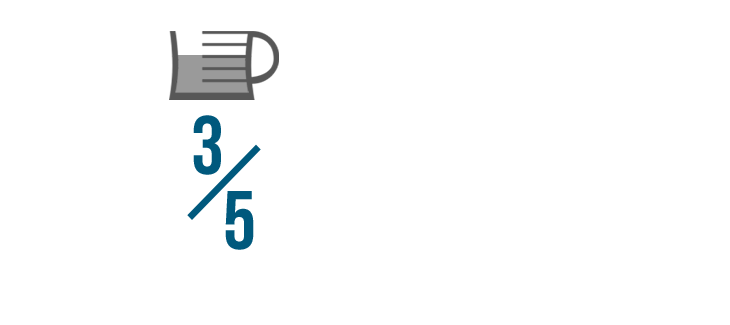
Let's imagine that a cake recipe tells you to add 3/5 of a cup of oil to the batter.
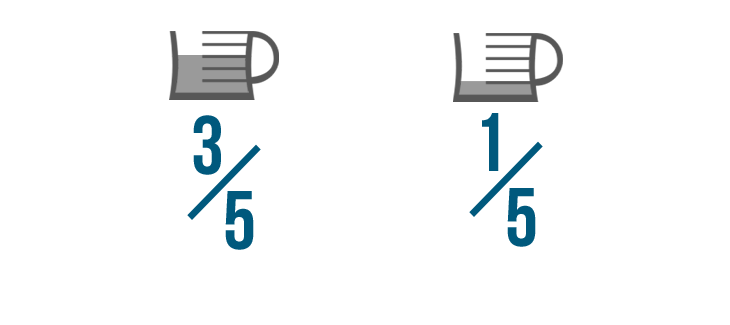
You also need 1/5 of a cup of oil to grease the pan. To see how much oil you'll need total, you can add these fractions together.
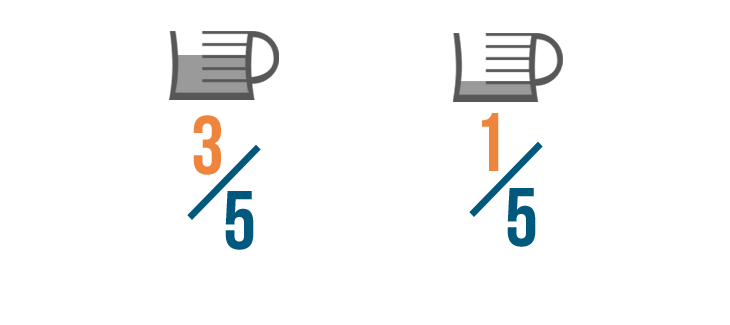
When you add fractions, you just add the top numbers, or numerators .
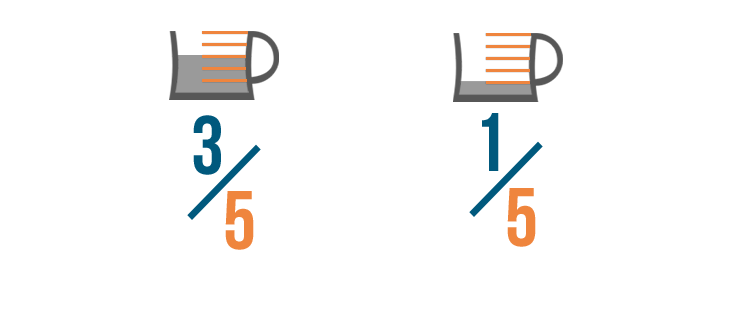
That's because the bottom numbers, or denominators , show how many parts would make a whole.
We don't want to change how many parts make a whole cup ( 5 ). We just want to find out how many parts we need total.
So we only need to add the numerators of our fractions.
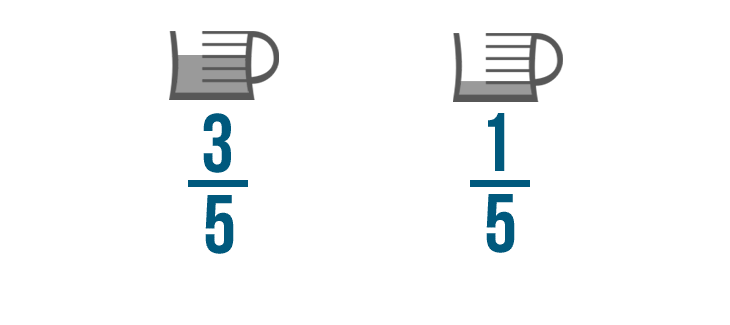
We can stack the fractions so the numerators are lined up. This will make it easier to add them.
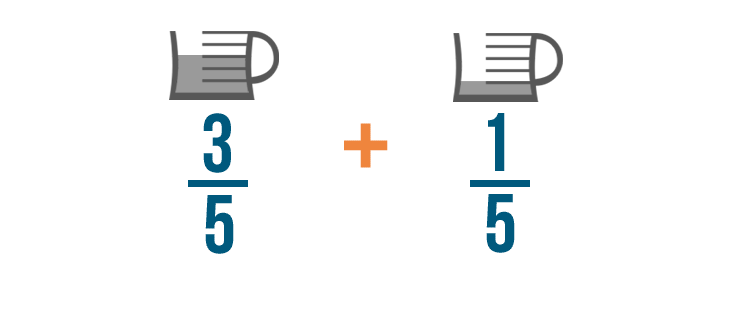
And that's all we have to do to set up an addition example with fractions. Our fractions are now ready to be added.

We'll do the same thing to set up a subtraction example. Let's say you had 3/4 of a tank of gas when you got to work.

If you use 1/4 of a tank to drive home, how much will you have left? We can subtract these fractions to find out.

Just like when we added, we'll stack our fractions to keep the numerators lined up.
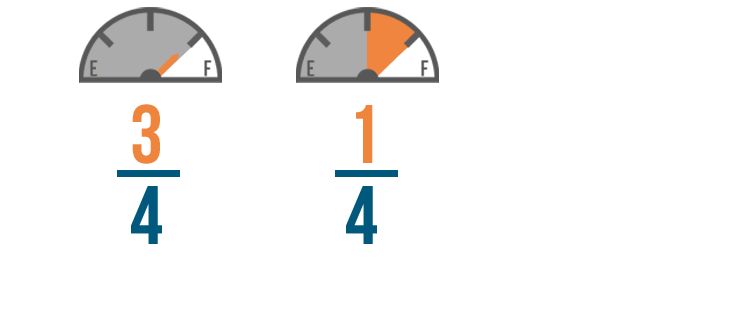
This is because we want to subtract 1 part from 3 parts.
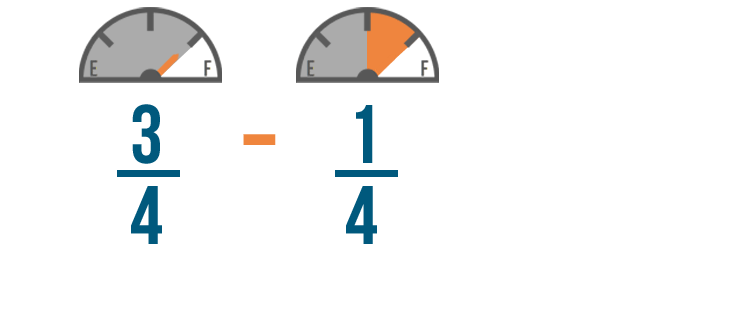
Now that our example is set up, we're ready to subtract!

Try setting up these addition and subtraction problems with fractions. Don't try solving them yet!
You run 4/10 of a mile in the morning. Later, you run for 3/10 of a mile.

You had 7/8 of a stick of butter and used 2/8 of the stick while cooking dinner.

Your gas tank is 2/5 full, and you put in another 2/5 of a tank.
Solving addition problems with fractions
Now that we know how to write addition problems with fractions, let's practice solving a few. If you can add whole numbers , you're ready to add fractions.
Click through the slideshow to learn how to add fractions.

Let's continue with our previous example and add these fractions: 3/5 of cup of oil and 1/5 of a cup of oil.
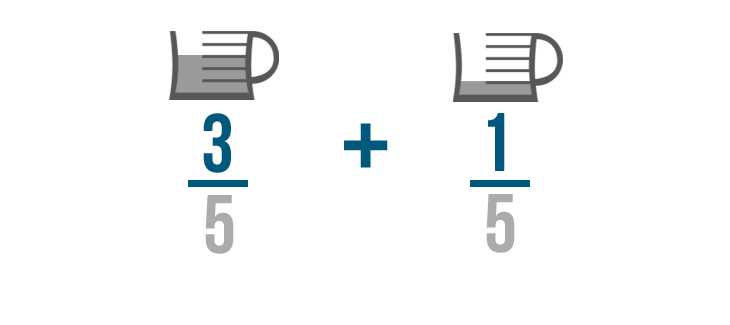
Remember, when we add fractions, we don't add the denominators.
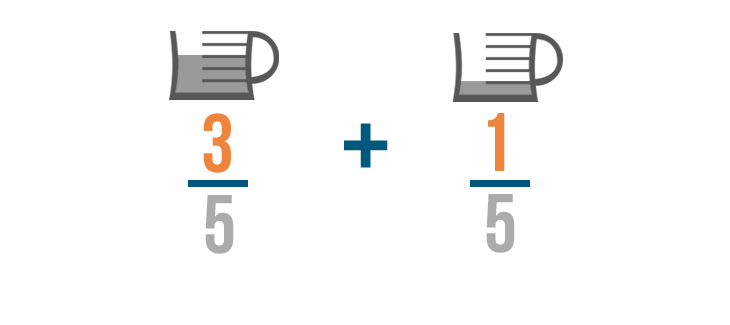
This is because we're finding how many parts we need total. The numerators show the parts we need, so we'll add 3 and 1 .
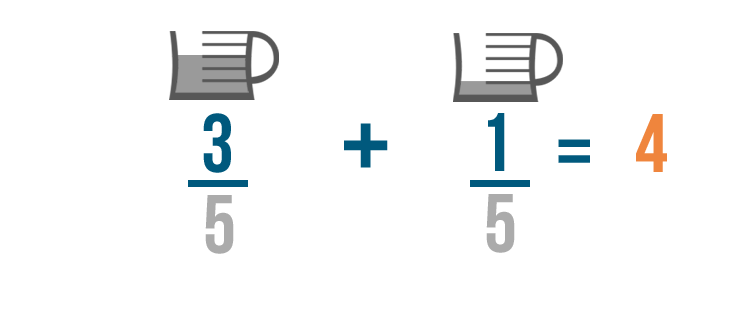
3 plus 1 equals 4 . Make sure to line up the 4 with the numbers you just added.
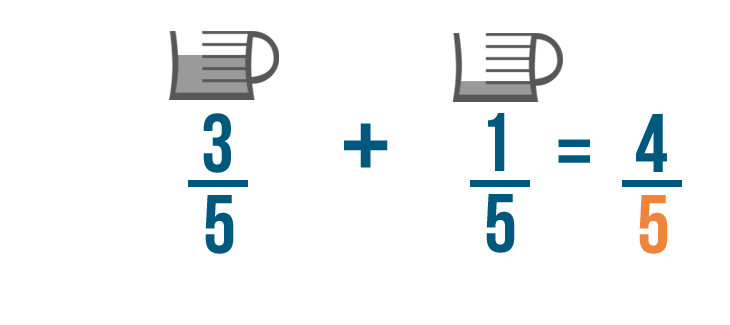
The denominators will stay the same, so we'll write 5 on the bottom of our new fraction.
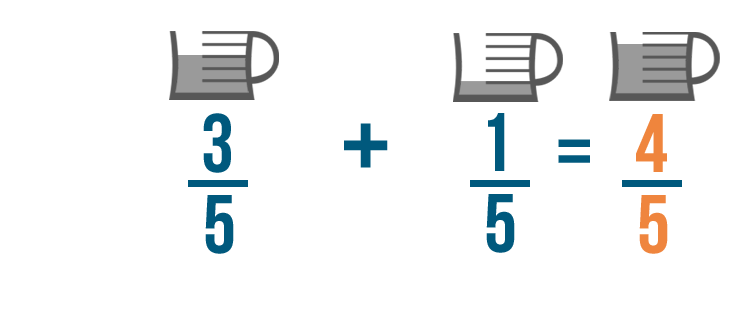
3/5 plus 1/5 equals 4/5 . So you'll need 4/5 of a cup of oil total to make your cake.
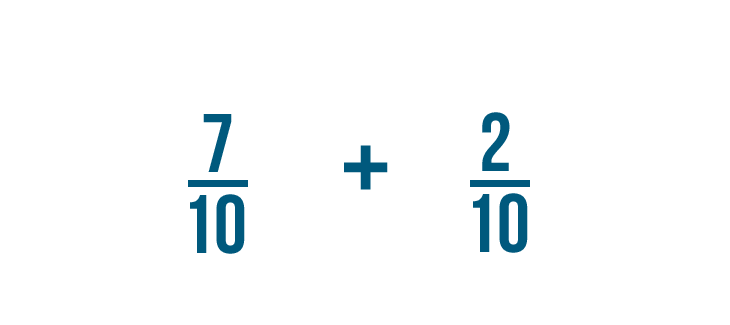
Let's try another example: 7/10 plus 2/10 .

Just like before, we're only going to add the numerators. In this example, the numerators are 7 and 2 .
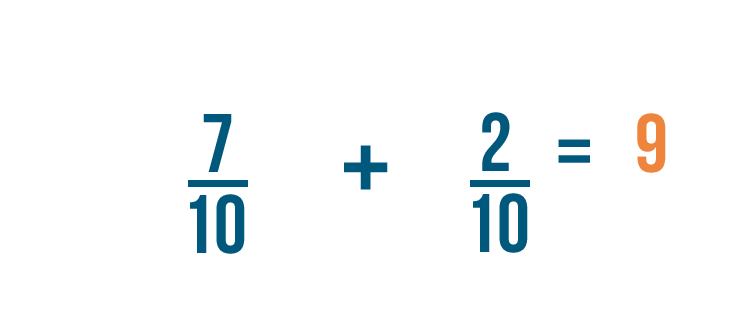
7 plus 2 equals 9 , so we'll write that to the right of the numerators.
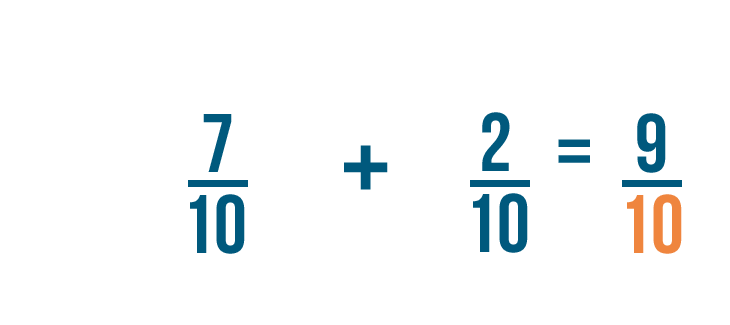
Just like in our earlier example, the denominator stays the same.
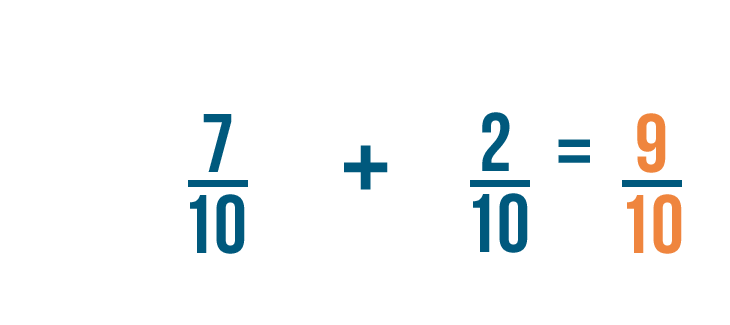
So 7/10 plus 2/10 equals 9/10 .
Try solving some of the addition problems below.
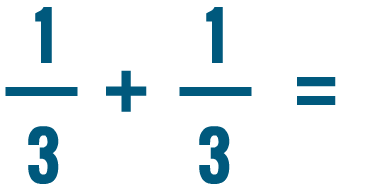
Solving subtraction problems with fractions
Subtracting fractions is a lot like regular subtraction. If you can subtract whole numbers , you can subtract fractions too!
Click through the slideshow to learn how to subtract fractions.
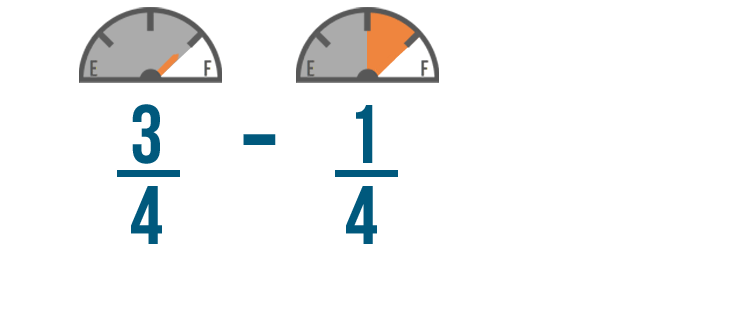
Let's use our earlier example and subtract 1/4 of a tank of gas from 3/4 of a tank.
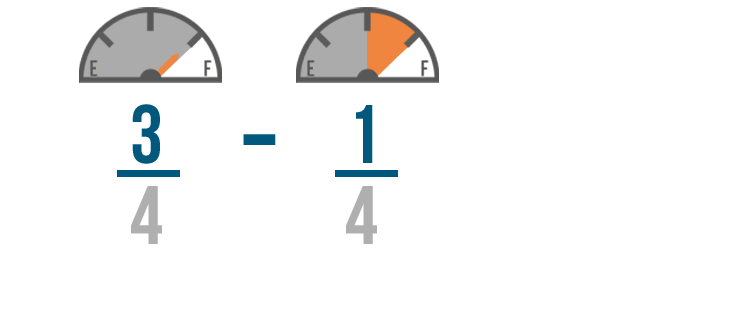
Just like in addition, we're not going to change the denominators.
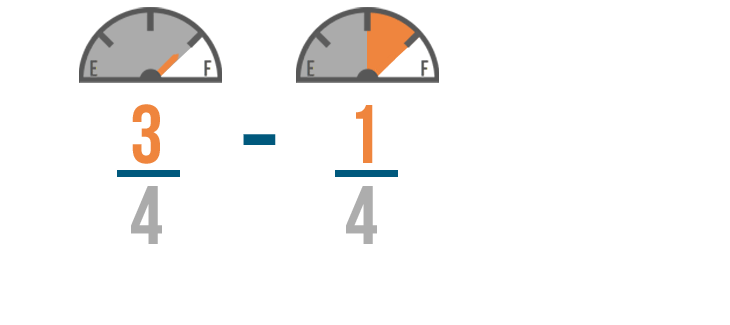
We don't want to change how many parts make a whole tank of gas. We just want to know how many parts we'll have left.
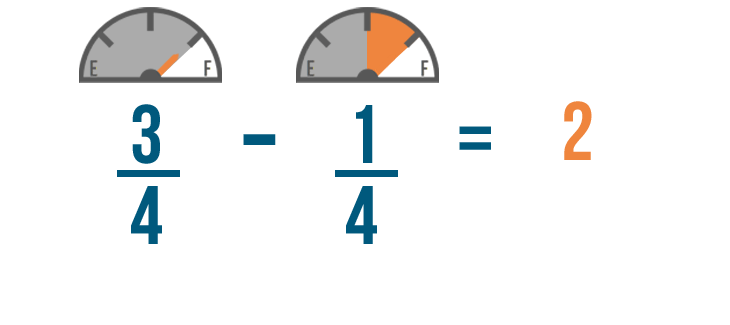
We'll start by subtracting the numerators. 3 minus 1 equals 2 , so we'll write 2 to the right of the numerators.

Just like when we added, the denominator of our answer will be the same as the other denominators.
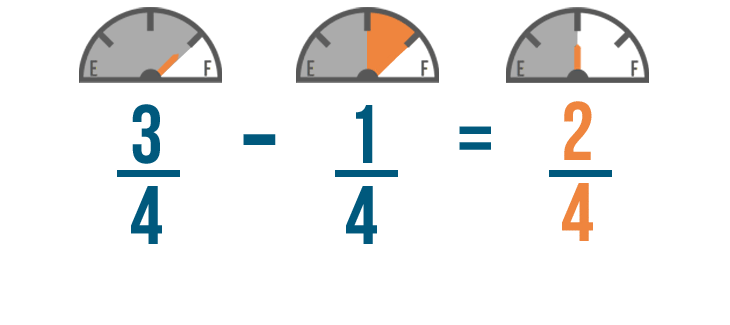
So 3/4 minus 1/4 equals 2/4 . You'll have 2/4 of a tank of gas left when you get home.
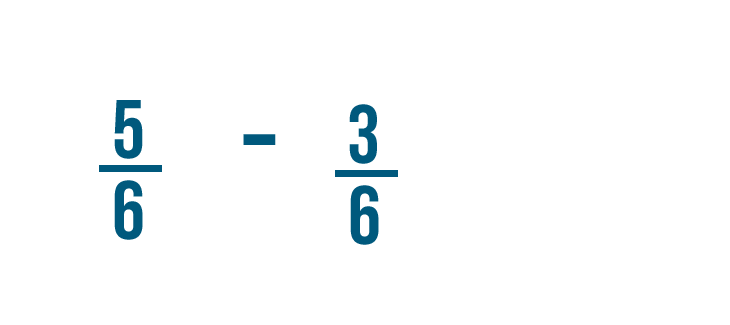
Let's try solving another problem: 5/6 minus 3/6 .
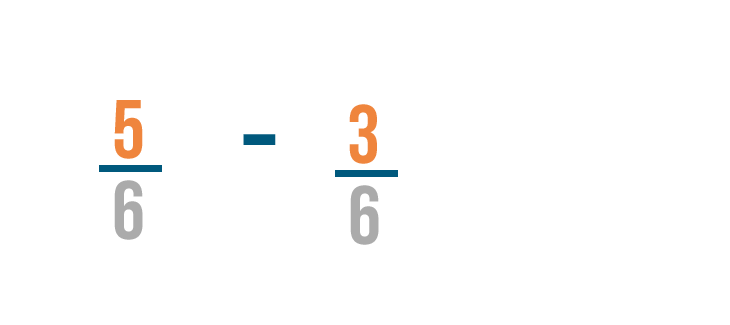
We'll start by subtracting the numerators.
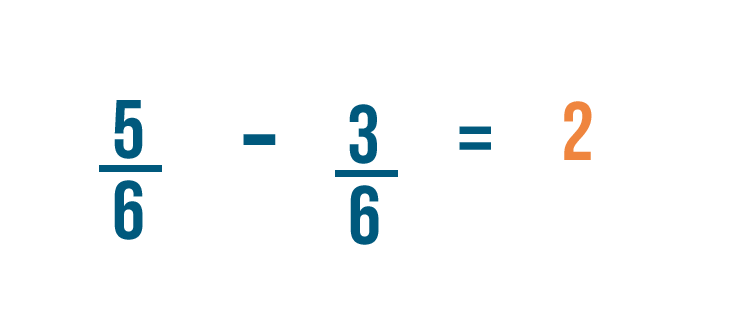
5 minus 3 equals 2 . So we'll put a 2 to the right of the numerators.
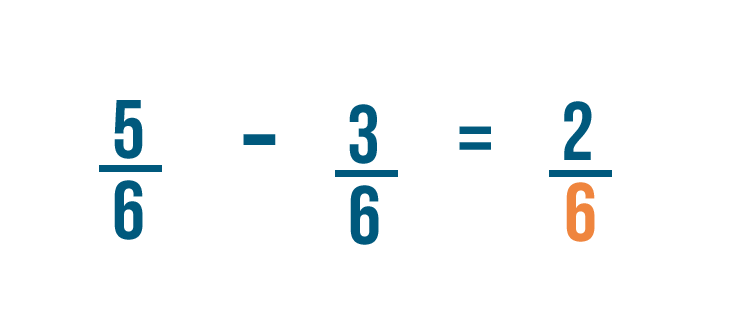
As usual, the denominator stays the same.
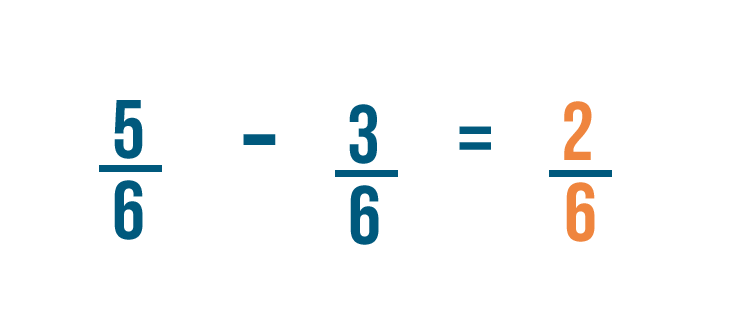
So 5/6 minus 3/6 equals 2/6 .
Try solving some of the subtraction problems below.
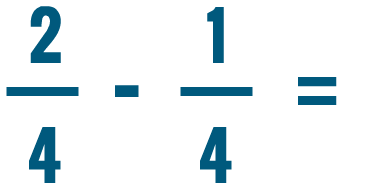
After you add or subtract fractions, you may sometimes have a fraction that can be reduced to a simpler fraction. As you learned in Comparing and Reducing Fractions , it's always best to reduce a fraction to its simplest form when you can. For example, 1/4 plus 1/4 equals 2/4 . Because 2 and 4 can both be divided 2 , we can reduce 2/4 to 1/2 .

Adding fractions with different denominators
On the last page, we learned how to add fractions that have the same denominator, like 1/4 and 3/4 . But what if you needed to add fractions with different denominators? For example, our cake recipe might say to blend 1/4 cup of milk in slowly and then dump in another 1/3 of a cup.
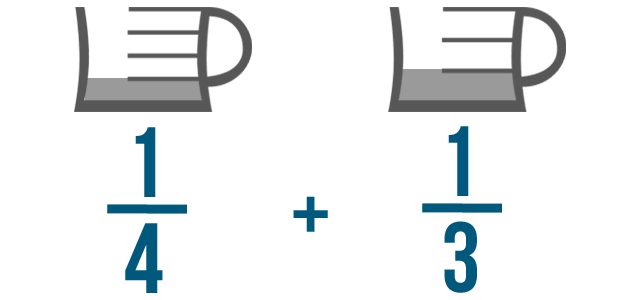
In Comparing and Reducing Fractions , we compared fractions with a different bottom number, or denominator. We had to change the fractions so their denominators were the same. To do that, we found the lowest common denominator , or LCD .
We can only add or subtract fractions if they have the same denominators. So we'll need to find the lowest common denominator before we add or subtract these fractions. Once the fractions have the same denominator, we can add or subtract as usual.
Click through the slideshow to learn how to add fractions with different denominators.
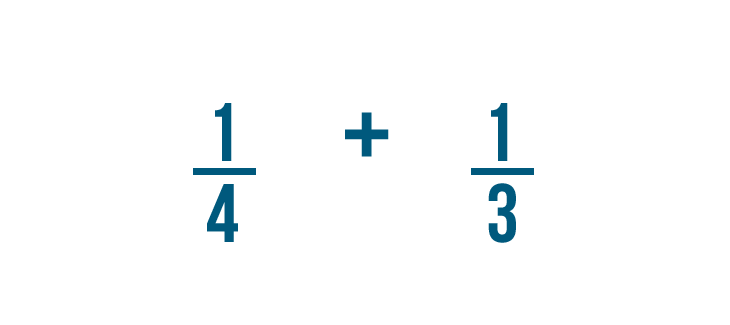
Let's add 1/4 and 1/3 .
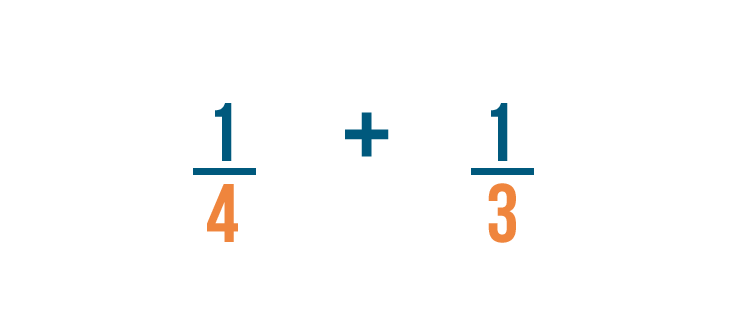
Before we can add these fractions, we'll need to change them so they have the same denominator .
To do that, we'll have to find the LCD , or lowest common denominator, of 4 and 3 .
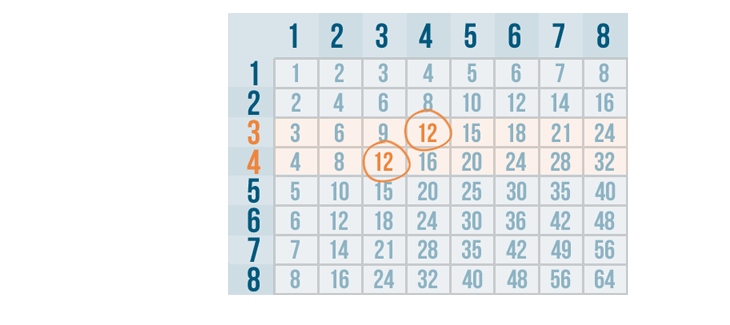
It looks like 12 is the smallest number that can be divided by both 3 and 4, so 12 is our LCD .
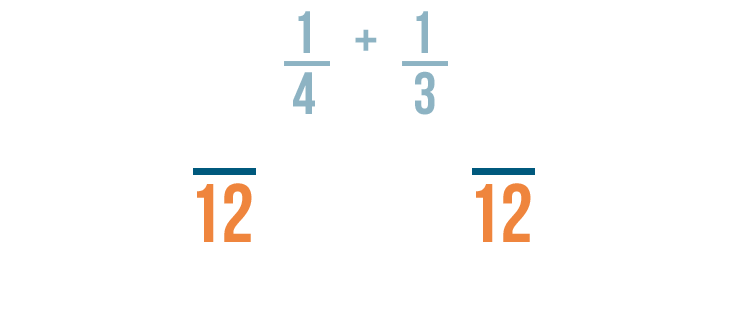
Since 12 is the LCD, it will be the new denominator for our fractions.
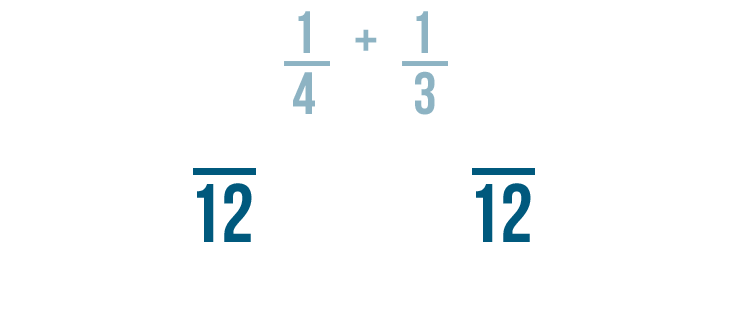
Now we'll change the numerators of the fractions, just like we changed the denominators.
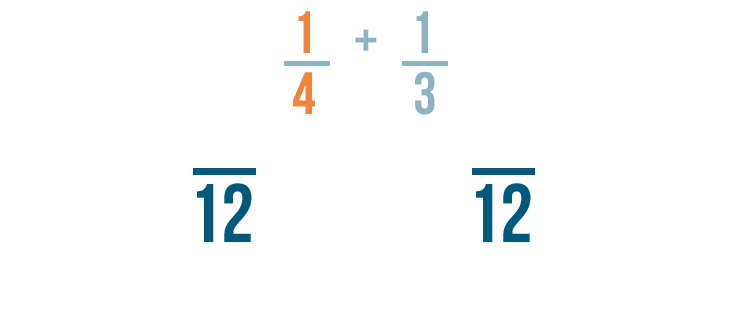
First, let's look at the fraction on the left: 1/4 .

To change 4 into 12 , we multiplied it by 3 .

Since the denominator was multiplied by 3 , we'll also multiply the numerator by 3 .
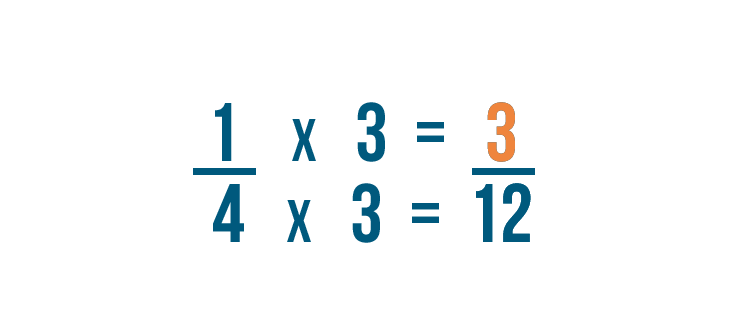
1 times 3 equals 3 .
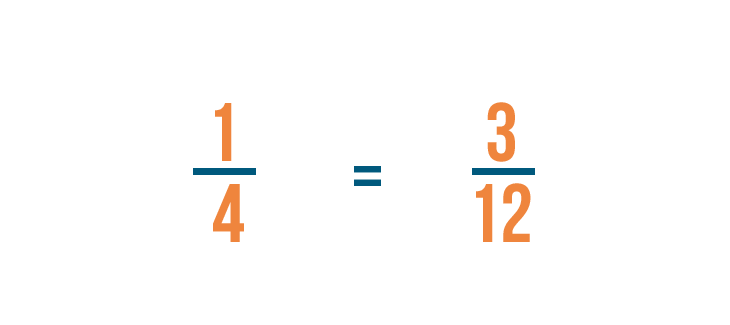
1/4 is equal to 3/12 .
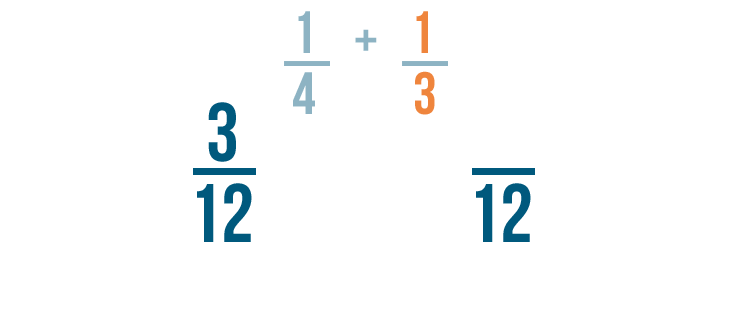
Now let's look at the fraction on the right: 1/3 . We changed its denominator to 12 as well.

Our old denominator was 3 . We multiplied it by 4 to get 12.
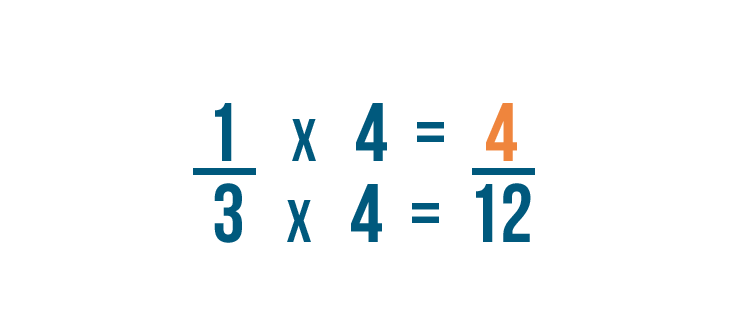
We'll also multiply the numerator by 4 . 1 times 4 equals 4 .
So 1/3 is equal to 4/12 .
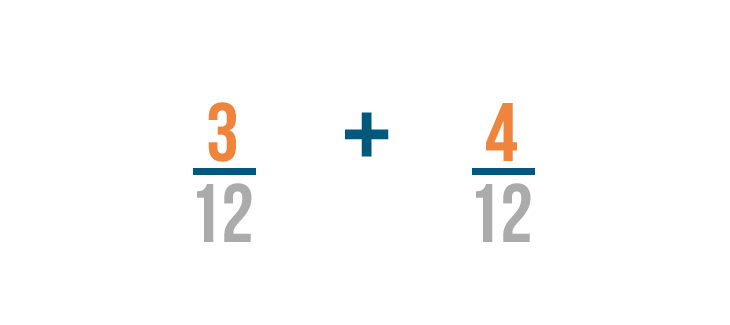
Now that our fractions have the same denominator, we can add them like we normally do.
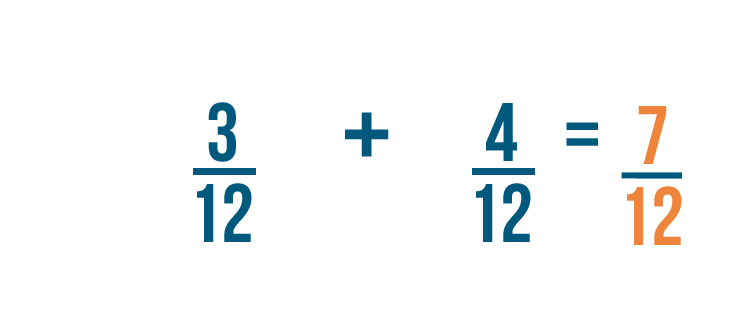
3 plus 4 equals 7 . As usual, the denominator stays the same. So 3/12 plus 4/12 equals 7/12 .
Try solving the addition problems below.
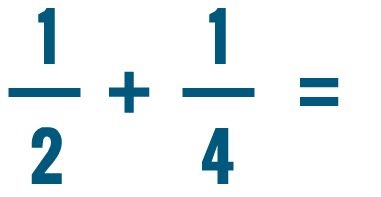
Subtracting fractions with different denominators
We just saw that fractions can only be added when they have the same denominator. The same thing is true when we're subtracting fractions. Before we can subtract, we'll have to change our fractions so they have the same denominator.
Click through the slideshow to learn how to subtract fractions with different denominators.
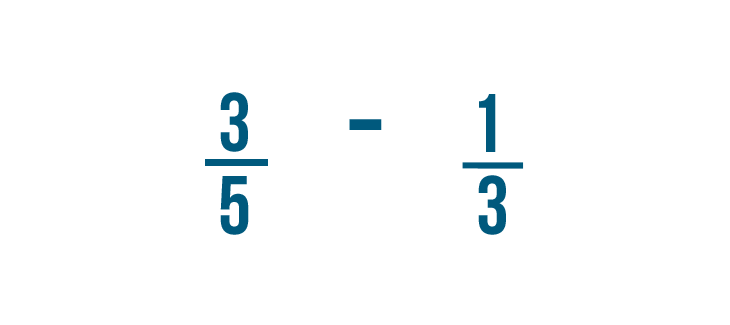
Let's try subtracting 1/3 from 3/5 .
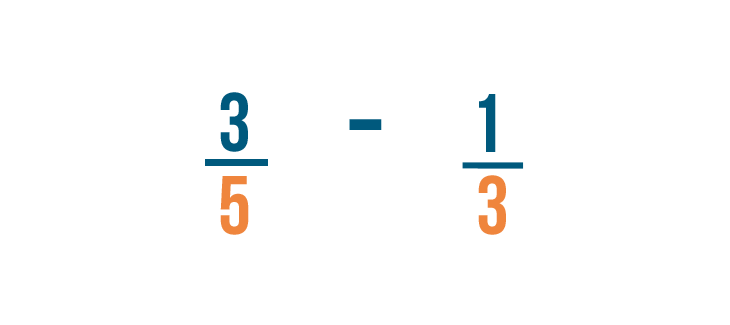
First, we'll change the denominators of both fractions to be the same by finding the lowest common denominator .

It looks like 15 is the smallest number that can be divided evenly by 3 and 5 , so 15 is our LCD.
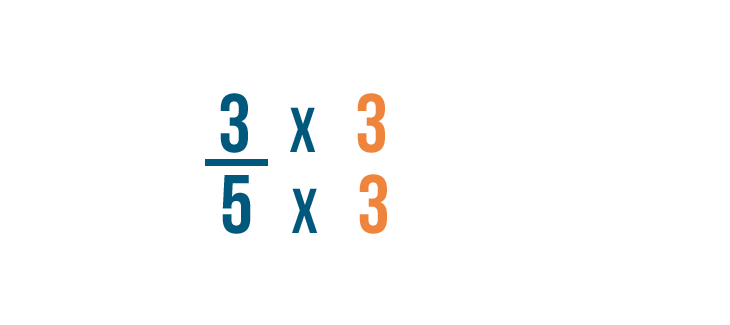
Now we'll change our first fraction. To change the denominator to 15 , we'll multiply the denominator and the numerator by 3 .
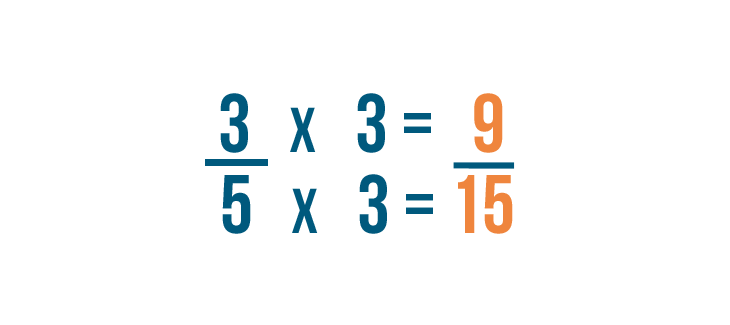
5 times 3 equals 15 . So our fraction is now 9/15 .
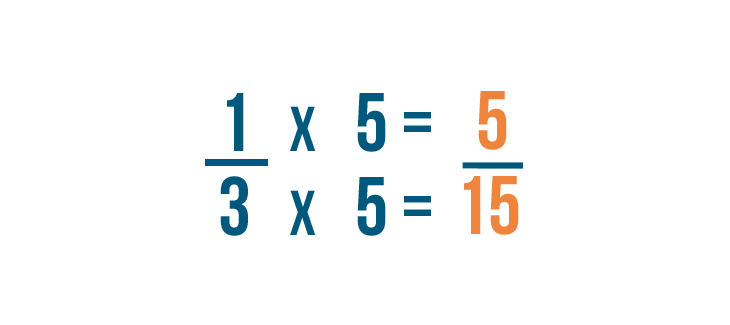
Now let's change the second fraction. To change the denominator to 15 , we'll multiply both numbers by 5 to get 5/15 .
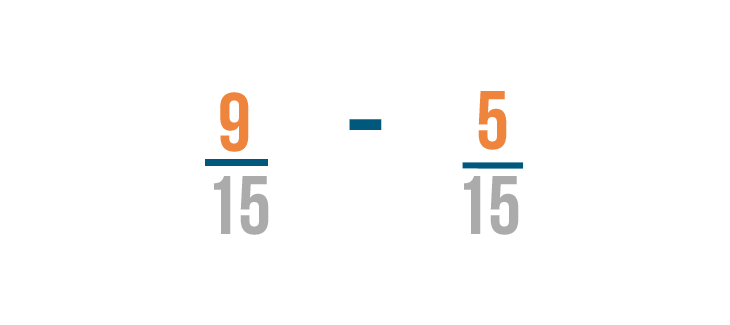
Now that our fractions have the same denominator, we can subtract like we normally do.
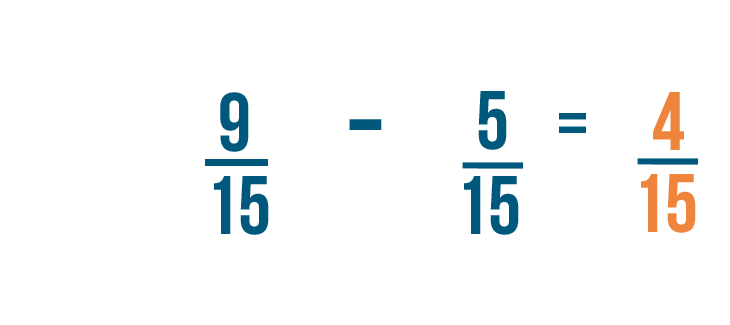
9 minus 5 equals 4 . As always, the denominator stays the same. So 9/15 minus 5/15 equals 4/15 .
Try solving the subtraction problems below.
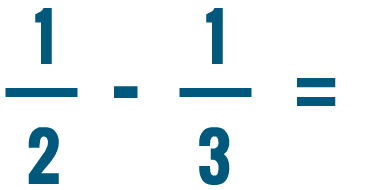
Adding and subtracting mixed numbers
Over the last few pages, you've practiced adding and subtracting different kinds of fractions. But some problems will need one extra step. For example, can you add the fractions below?
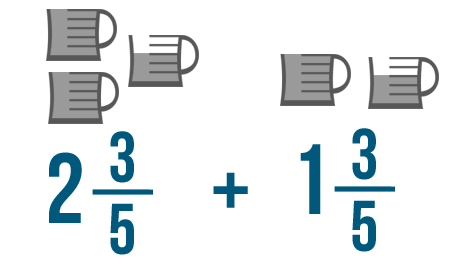
In Introduction to Fractions , you learned about mixed numbers . A mixed number has both a fraction and a whole number . An example is 2 1/2 , or two-and-a-half . Another way to write this would be 5/2 , or five-halves . These two numbers look different, but they're actually the same.
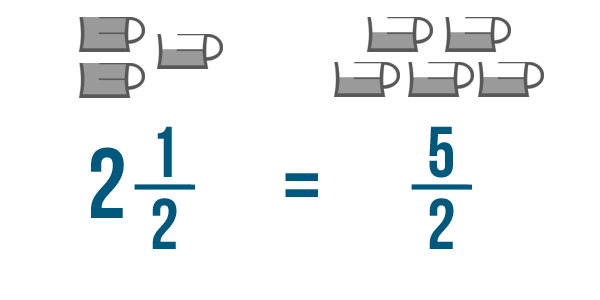
5/2 is an improper fraction . This just means the top number is larger than the bottom number. Even though improper fractions look strange, you can add and subtract them just like normal fractions. Mixed numbers aren't easy to add, so you'll have to convert them into improper fractions first.
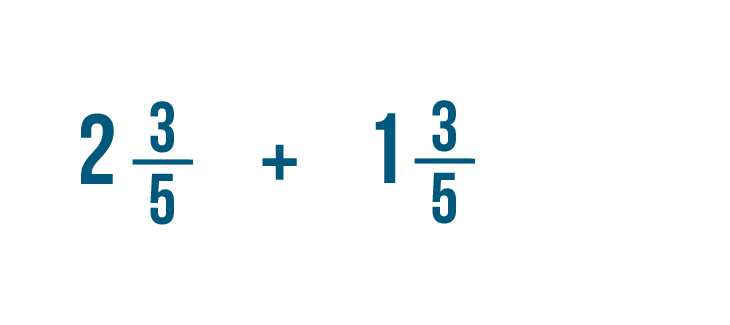
Let's add these two mixed numbers: 2 3/5 and 1 3/5 .
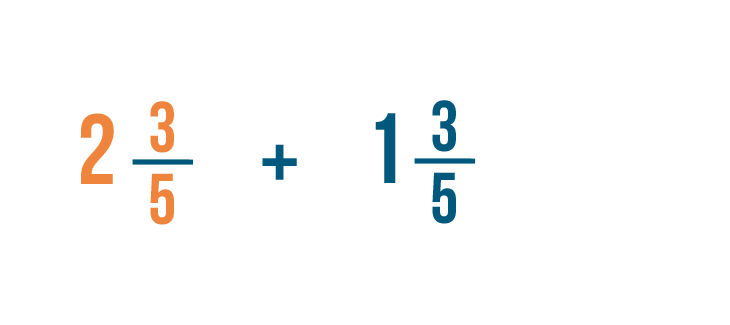
We'll need to convert these mixed numbers to improper fractions. Let's start with 2 3/5 .
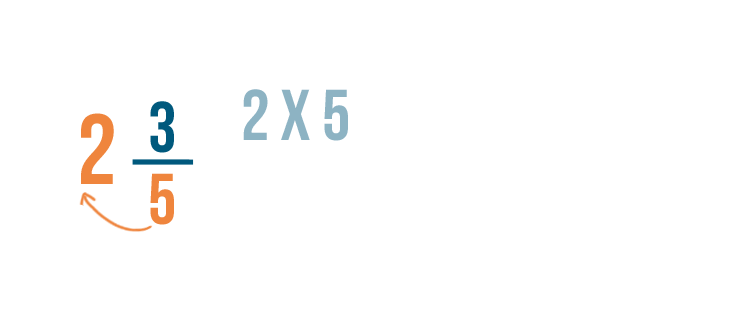
As you learned in Lesson 2 , we'll multiply the whole number, 2 , by the bottom number, 5 .
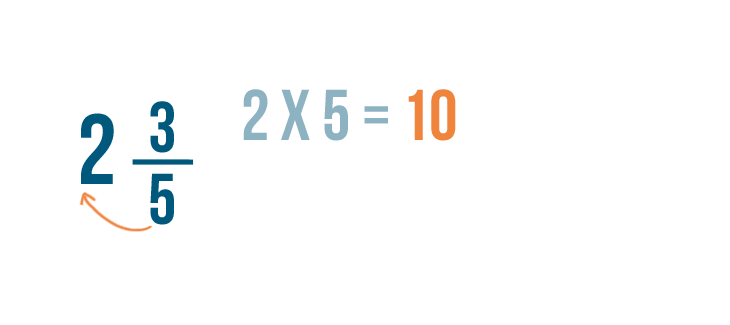
2 times 5 equals 10 .
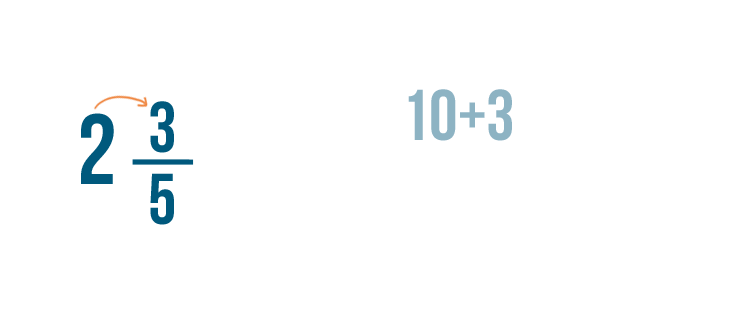
Now, let's add 10 to the numerator, 3 .

10 + 3 equals 13 .

Just like when you add fractions, the denominator stays the same. Our improper fraction is 13/5 .
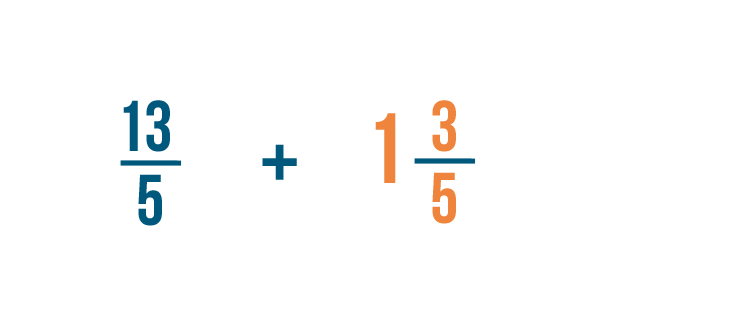
Now we'll need to convert our second mixed number: 1 3/5 .
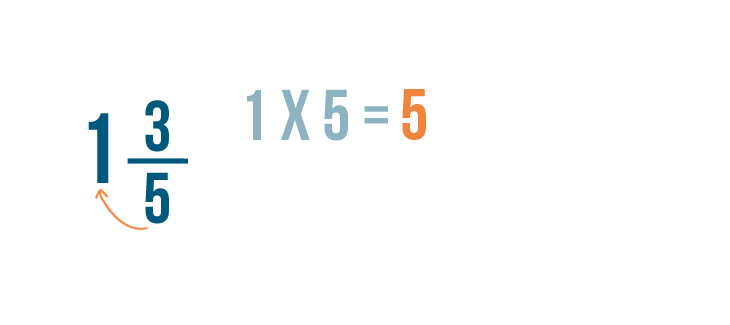
First, we'll multiply the whole number by the denominator. 1 x 5 = 5 .
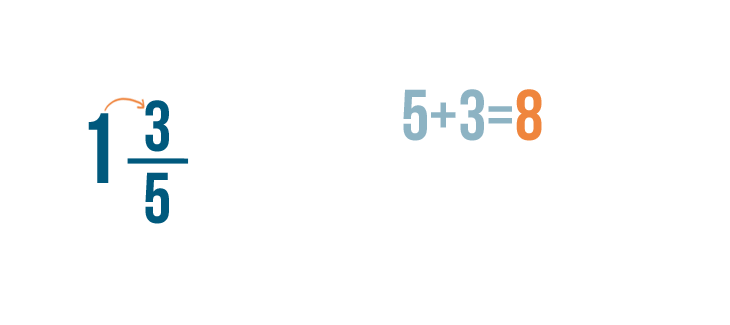
Next, we'll add 5 to the numerators. 5 + 3 = 8 .

Just like last time, the denominator remains the same. So we've changed 1 3/5 to 8/5 .
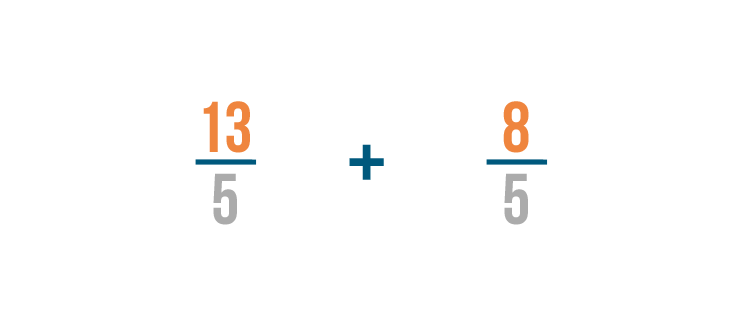
Now that we've changed our mixed numbers to improper fractions, we can add like we normally do.
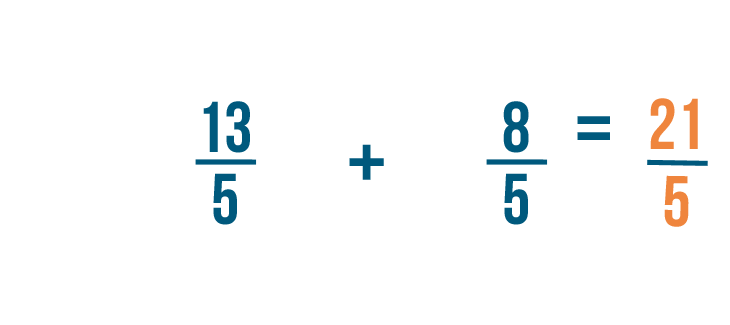
13 plus 8 equals 21 . As usual, the denominator will stay the same. So 13/5 + 8/5 = 21/5 .
Because we started with a mixed number, let's convert this improper fraction back into a mixed number.
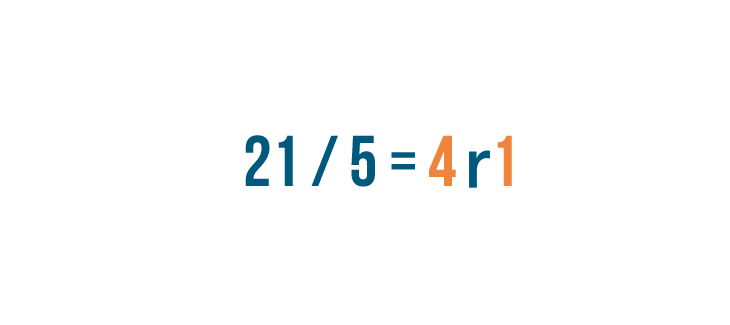
As you learned in the previous lesson , divide the top number by the bottom number. 21 divided by 5 equals 4, with a remainder of 1 .

The answer, 4, will become our whole number.

And the remainder , 1, will become the numerator of the fraction.
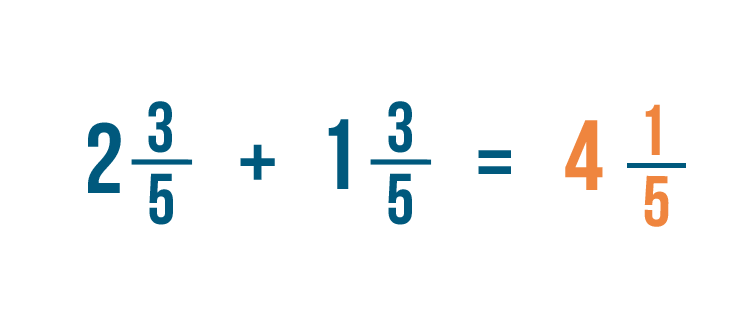
So 2 3/5 + 1 3/5 = 4 1/5 .
/en/fractions/multiplying-and-dividing-fractions/content/

- school Campus Bookshelves
- menu_book Bookshelves
- perm_media Learning Objects
- login Login
- how_to_reg Request Instructor Account
- hub Instructor Commons
- Download Page (PDF)
- Download Full Book (PDF)
- Periodic Table
- Physics Constants
- Scientific Calculator
- Reference & Cite
- Tools expand_more
- Readability
selected template will load here
This action is not available.

4.9: Solving Equations with Fractions
- Last updated
- Save as PDF
- Page ID 24084

- David Arnold
- College of the Redwoods
Undoing Subtraction
We can still add the same amount to both sides of an equation without changing the solution.
Solve for x : \(x - \frac{5}{6} = \frac{1}{3}\).
To “undo” subtracting 5/6, add 5/6 to both sides of the equation and simplify.
\[ \begin{aligned} x - \frac{5}{6} = \frac{1}{3} ~ & \textcolor{red}{ \text{ Original equation.}} \\ x - \frac{5}{6} + \frac{5}{6} = \frac{1}{3} + \frac{5}{6} ~ & \textcolor{red}{ \text{ Add } \frac{5}{6} \text{ to both sides.}} \\ x = \frac{1 \cdot 2}{3 \cdot 2} + \frac{5}{6} ~ & \textcolor{red}{ \text{ Equivalent fractions, LCD = 6.}} \\ x = \frac{2}{6} + \frac{5}{6} ~ & \textcolor{red}{ \text{ Simplify.}} \\ x = \frac{7}{6} ~ & \textcolor{red}{ \text{ Add.}} \end{aligned}\nonumber \]
It is perfectly acceptable to leave your answer as an improper fraction. If you desire, or if you are instructed to do so, you can change your answer to a mixed fraction (7 divided by 6 is 1 with a remainder of 1). That is \(x = 1 \frac{1}{6}\).
Checking the Solution
Substitute 7/6 for x in the original equation and simplify.
\[ \begin{aligned} x - \frac{5}{6} = \frac{1}{3} ~ & \textcolor{red}{ \text{ Original equation.}} \\ \frac{7}{6} - \frac{5}{6} = \frac{1}{3} ~ & \textcolor{red}{ \text{ Substitute 7/6 for } x.} \\ \frac{2}{6} = \frac{1}{3} ~ & \textcolor{red}{ \text{ Subtract.}} \\ \frac{1}{3} = \frac{1}{3} ~ & \textcolor{red}{ \text{ Reduce.}} \end{aligned}\nonumber \]
Because the last statement is true, we conclude that 7/6 is a solution of the equation x − 5/6 = 1/3.
Undoing Addition
You can still subtract the same amount from both sides of an equation without changing the solution.
Solve for x : \(x + \frac{2}{3} = - \frac{3}{5}\).
To “undo” adding 2/3, subtract 2/3 from both sides of the equation and simplify.
\[ \begin{aligned} x + \frac{2}{3} = - \frac{3}{5} ~ & \textcolor{red}{ \text{ Original equation.}} \\ x + \frac{2}{3} - \frac{2}{3} = - \frac{3}{5} - \frac{2}{3} ~ & \textcolor{red}{ \text{ Subtract } \frac{2}{3} \text{ from both sides.}} \\ x = - \frac{3 \cdot 3}{5 \cdot 3} - \frac{2 \cdot 5}{3 \cdot 5} ~ & \textcolor{red}{ \text{ Equivalent fractions, LCD = 15.}} \\ x = - \frac{9}{15} - \frac{10}{15} ~ & \textcolor{red}{ \text{ Simplify.}} \\ x = - \frac{19}{15} ~ & \textcolor{red}{ \text{ Subtract.}} \end{aligned}\nonumber \]
Readers are encouraged to check this solution in the original equation.
Solve for x : \(x + \frac{3}{4} = - \frac{1}{2}\)
Undoing Multiplication
We “undo” multiplication by dividing. For example, to solve the equation 2 x = 6, we would divide both sides of the equation by 2. In similar fashion, we could divide both sides of the equation
\[ \frac{3}{5} x = \frac{4}{10}\nonumber \]
by 3/5. However, it is more efficient to take advantage of reciprocals. For convenience, we remind readers of the Multiplicative Inverse Property .
Multiplicative Inverse Property
Let a / b be any fraction. The number b / a is called the multiplicative inverse or reciprocal of a / b . The product of reciprocals is 1.
\[ \frac{a}{b} \cdot \frac{b}{a} = 1.\nonumber \]
Let’s put our knowledge of reciprocals to work.
Solve for x : \(\frac{3}{5}x = \frac{4}{10}\).
To “undo” multiplying by 3/5, multiply both sides by the reciprocal 5/3 and simplify.
\[ \begin{aligned} \frac{3}{5} x = \frac{4}{10} ~ & \textcolor{red}{ \text{ Original equation.}} \\ \frac{5}{3} \left( \frac{3}{5} x \right) = \frac{5}{3} \left( \frac{4}{10} \right) & ~ \textcolor{red}{ \text{ Multiply both sides by 5/3.}} \\ \left( \frac{5}{3} \cdot \frac{3}{5} \right) x = \frac{20}{30} ~ & \textcolor{red}{ \begin{array}{l} \text{ On the left, use the associative property to regroup.} \\ \text{ On the right, multiply.} \end{array}} \\ 1x = \frac{2}{3} ~ & \textcolor{red}{ \begin{array}{l} \text{ On the left, } \frac{5}{3} \cdot \frac{3}{5} = 1. \\ \text{ On the right, reduce: } \frac{20}{30} = \frac{2}{3}. \end{array}} \\ x = \frac{2}{3} ~ & \textcolor{red}{ \text{ On the left, } 1x = x.} \end{aligned}\nonumber \]
Substitute 2/3 for x in the original equation and simplify.
\[ \begin{aligned} \frac{3}{5} x = \frac{4}{10} ~ & \textcolor{red}{ \text{ Original equation.}} \\ \frac{3}{5} \left( \frac{2}{3} \right) = \frac{4}{10} ~ & \textcolor{red}{ \text{ Substitute 2/3 for }x.} \\ \frac{6}{15} = \frac{4}{10} ~ & \textcolor{red}{ \text{ Multiply numerators; multiply denominators.}} \\ \frac{2}{5} = \frac{2}{5} ~ & \textcolor{red}{ \text{ Reduce both sides to lowest terms.}} \end{aligned}\nonumber \]
Because this last statement is true, we conclude that 2/3 is a solution of the equation (3/5) x = 4/10.
Solve for y : \( \frac{2}{3} y = \frac{4}{5}\)
Solve for x : \(- \frac{8}{9} x = \frac{5}{18}\).
To “undo” multiplying by −8/9, multiply both sides by the reciprocal −9/8 and simplify.
\[ \begin{aligned} - \frac{8}{9} x = \frac{5}{18} ~ & \textcolor{red}{ \text{ Original equation.}} \\ - \frac{9}{8} \left( - \frac{8}{9} x \right) = - \frac{9}{8} \left( \frac{5}{18} \right) ~ & \textcolor{red}{ \text{ Multiply both sides by } -9/8.} \\ \left[ - \frac{9}{8} \cdot \left( - \frac{8}{9} \right) \right] x = - \frac{3 \cdot 3}{2 \cdot 2 \cdot 2} \cdot \frac{5}{2 \cdot 3 \cdot 3} ~ & \textcolor{red}{ \begin{array}{l} \text{ On the left, use the associative property to regroup.} \\ \text{ On the right, prime factor.} \end{array}} 1x = \frac{ \cancel{3} \cdot \cancel{3}}{2 \cdot 2 \cdot 2} \cdot \frac{5}{2 \cdot \cancel{3} \cdot \cancel{3}} ~ & \textcolor{red}{ \begin{array}{l} \text{ On the left, } - \frac{9}{8} \cdot \left( - \frac{8}{9} \right) = 1. \\ \text{ On the right, cancel common factors.} \end{array}} \\ x = - \frac{5}{16} ~ & \textcolor{red}{ \text{ On the left, } 1x = x. \text{ Multiply on the right.}} \end{aligned}\nonumber \]
Solve for z: \(− \frac{2}{7} z = \frac{4}{21}\)
Clearing Fractions from the Equation
Although the technique demonstrated in the previous examples is a solid mathematical technique, working with fractions in an equation is not always the most efficient use of your time.
To clear all fractions from an equation, multiply both sides of the equation by the least common denominator of the fractions that appear in the equation.
Let’s put this idea to work.
In Example 1, we were asked to solve the following equation for x :
\[x - \frac{5}{6} = \frac{1}{3}.\nonumber \]
Take a moment to review the solution technique in Example 1. We will now solve this equation by first clearing all fractions from the equation.
Multiply both sides of the equation by the least common denominator for the fractions appearing in the equation.
\[ \begin{aligned} x - \frac{5}{6}= \frac{1}{3} ~ & \textcolor{red}{ \text{ Original equation.}} \\ 6 \left( x - \frac{5}{6} \right) = 6 \left( \frac{1}{3} \right) ~ & \textcolor{red}{ \text{ Multiply both sides by 6.}} \\ 6x - 6 \left( \frac{5}{6} \right) = 6 \left( \frac{1}{3} \right) ~ & \textcolor{red}{ \text{ Distribute the 6.}} \\ 6x-5 = 2 ~ & \textcolor{red}{ \text{ On each side, multiply first.}} \\ ~ & \textcolor{red}{6 \left( \frac{5}{6} \right) = 5 \text{ and } 6 \left( \frac{1}{3} \right) = 2.} \end{aligned}\nonumber \]
Note that the equation is now entirely clear of fractions, making it a much simpler equation to solve.
\[ \begin{aligned} 6x - 5 + 5 = 2 + 5 ~ & \textcolor{red}{ \text{ Add 5 to both sides.}} \\ 6x = 7 ~ & \textcolor{red}{ \text{ Simplify both sides.}} \\ \frac{6x}{6} = \frac{7}{6} ~ & \textcolor{red}{ \text{ Divide both sides by 6.}} \\ x = \frac{7}{6} ~ & \textcolor{red}{ \text{ Simplify.}} \end{aligned}\nonumber \]
Note that this is the same solution found in Example 1.
Solve for t : \(t - \frac{2}{7} = - \frac{1}{4}\)
In Example 4, we were asked to solve the following equation for x .
\[- \frac{8}{9}x = \frac{5}{18}\nonumber \]
Take a moment to review the solution in Example 4. We will now solve this equation by first clearing all fractions from the equation.
Multiply both sides of the equation by the least common denominator for the fractions that appear in the equation.
\[ \begin{aligned} - \frac{8}{9} x = \frac{5}{18} ~ & \textcolor{red}{ \text{ Original equation.}} \\ 18 \left( - \frac{8}{9} x \right) = 18 \left( \frac{5}{18} \right) ~ & \textcolor{red}{ \text{ Multiply both sides by 18.}} \\ -16x=5 ~ & \textcolor{red}{ \text{ On each side, cancel and multiply.}} \\ ~ & \textcolor{red}{ 18 \left( - \frac{8}{9} \right) = -16 \text{ and } 18 \left( \frac{5}{18} \right) = 5.} \end{aligned}\nonumber \]
Note that the equation is now entirely free of fractions. Continuing,
\[ \begin{aligned} \frac{-16x}{-16} = \frac{5}{-16} ~ & \textcolor{red}{ \text{ Divide both sides by } -16.} \\ x = - \frac{5}{16} ~ & \textcolor{red}{ \text{ Simplify.}} \end{aligned}\nonumber \]
Note that this is the same as the solution found in Example 4.
Solve for u :
\[ - \frac{7}{9} u = \frac{14}{27}\nonumber \]
Solve for x : \(\frac{2}{3}x + \frac{3}{4} = \frac{1}{2}\).
\[ \begin{aligned} \frac{2}{3} x + \frac{3}{4} = \frac{1}{2} ~ & \textcolor{red}{ \text{ Original equation.}} \\ 12 \left( \frac{2}{3} x + \frac{3}{4} = \right) = 12 \left( \frac{1}{2} \right) ~ & \textcolor{red}{ \text{ Multiply both sides by 12.}} \\ 12 \left( \frac{2}{3}x \right) + 12 \left( \frac{3}{4} \right) = 12 \left( \frac{1}{2} \right) ~ & \textcolor{red}{ \text{ On the left, distribute 12.}} \\ 8x + 9 = 6 ~ & \textcolor{red}{ \text{ Multiply: } 12 \left( \frac{2}{3} x \right) = 8x, ~ 12 \left( \frac{3}{4} \right) = 9,} \\ ~ & \textcolor{red}{ \text{ and } 12 \left( \frac{1}{2} \right) = 6.} \end{aligned}\nonumber \]
Note that the equation is now entirely free of fractions. We need to isolate the terms containing x on one side of the equation.
\[ \begin{aligned} 8x + 9 - 9 = 6 - 9 ~ & \textcolor{red}{ \text{ Subtract 9 from both sides.}} \\ 8x = - 3 ~ & \textcolor{red}{ \text{ Simplify both sides.}} \\ \frac{8x}{8} = \frac{-3}{8} ~ & \textcolor{red}{ \text{ Divide both sides by 8.}} \\ x = - \frac{3}{8} ~ & \textcolor{red}{ \text{ Simplify both sides.}} \end{aligned}\nonumber \]
Solve for r : \(\frac{3}{4} r + \frac{2}{3} = \frac{1}{2}\)
Solve for x : \( \frac{2}{3} - \frac{3x}{4} = \frac{x}{2} - \frac{1}{8}.\)
Multiply both sides of the equation by the least common denominator for the fractions in the equation.
\[ \begin{aligned} \frac{2}{3} - \frac{3x}{4} = \frac{x}{2} - \frac{1}{8} ~ & \textcolor{red}{ \text{ Original equation.}} \\ 24 \left( \frac{2}{3} - \frac{3x}{4} \right) = 24 \left( \frac{x}{2} - \frac{1}{8} \right) ~ & \textcolor{red}{ \text{ Multiply both sides by 24.}} \\ 24 \left( \frac{2}{3} \right) - 24 \left( \frac{3x}{4} \right) = 24 \left( \frac{x}{2} \right) - 24 \left( \frac{1}{8} \right) ~ & \textcolor{red}{ \text{ On both sides, distribute 24.}} \\ 16 - 18x = 12x - 3 ~ & \textcolor{red}{ \text{ Left: } 24 \left( \frac{2}{3} \right) = 16, ~ 24 \left( \frac{3x}{4} \right) = 18x.} \\ ~ & \textcolor{red}{ \text{ Right: } 24 \left( \frac{x}{2} \right) = 12x, ~ 24 \left( \frac{1}{8} \right) = 3.} \end{aligned}\nonumber \]
\[ \begin{aligned} 16 - 18x - 12x = 12x - 3 - 12x ~ & \textcolor{red}{ \text{ Subtract } 12x \text{ from both sides.}} \\ 16 - 30x = -3 ~ & \textcolor{red}{ \begin{aligned} \text{ Left: } -18x - 12x = -30x. \\ \text{ Right: } 12x - 12x = 0. \end{aligned}} \\ 16 - 30x - 16 = -3 - 16 ~ & \textcolor{red}{ \text{ Subtract 16 from both sides.}} \\ -30x = -19 ~ & \textcolor{red}{ \begin{aligned} \text{ Left: } 16-16=0. \\ \text{ Right: } -3 - 16 = -19. \end{aligned}} \\ \frac{-30x}{-30} = \frac{-19}{-30} ~ & \textcolor{red}{ \text{ Divide both sides by } -30.} \\ x = \frac{19}{30} ~ & \textcolor{red}{ \text{ Simplify both sides.}} \end{aligned}\nonumber \]
Solve for s : \( \frac{3}{2} - \frac{2s}{5} = \frac{s}{3} - \frac{1}{5}\).
Add texts here. Do not delete this text first.
Solver Title
Generating PDF...
- Pre Algebra Order of Operations Factors & Primes Fractions Long Arithmetic Decimals Exponents & Radicals Ratios & Proportions Percent Modulo Number Line Mean, Median & Mode
- Algebra Equations Inequalities System of Equations System of Inequalities Basic Operations Algebraic Properties Partial Fractions Polynomials Rational Expressions Sequences Power Sums Interval Notation Pi (Product) Notation Induction Logical Sets Word Problems
- Pre Calculus Equations Inequalities Scientific Calculator Scientific Notation Arithmetics Complex Numbers Polar/Cartesian Simultaneous Equations System of Inequalities Polynomials Rationales Functions Arithmetic & Comp. Coordinate Geometry Plane Geometry Solid Geometry Conic Sections Trigonometry
- Calculus Derivatives Derivative Applications Limits Integrals Integral Applications Integral Approximation Series ODE Multivariable Calculus Laplace Transform Taylor/Maclaurin Series Fourier Series Fourier Transform
- Functions Line Equations Functions Arithmetic & Comp. Conic Sections Transformation
- Linear Algebra Matrices Vectors
- Trigonometry Identities Proving Identities Trig Equations Trig Inequalities Evaluate Functions Simplify
- Statistics Mean Geometric Mean Quadratic Mean Average Median Mode Order Minimum Maximum Probability Mid-Range Range Standard Deviation Variance Lower Quartile Upper Quartile Interquartile Range Midhinge Standard Normal Distribution
- Physics Mechanics
- Chemistry Chemical Reactions Chemical Properties
- Finance Simple Interest Compound Interest Present Value Future Value
- Economics Point of Diminishing Return
- Conversions Roman Numerals Radical to Exponent Exponent to Radical To Fraction To Decimal To Mixed Number To Improper Fraction Radians to Degrees Degrees to Radians Hexadecimal Scientific Notation Distance Weight Time Volume
- Pre Algebra
- Two-step without parentheses
- Two-step with parentheses
- Three/four steps without parentheses
- Three/four steps with parentheses
- Multi-step without parentheses
- Multi-step with parentheses
- Prime Factorization
- Negative Factors
- Positive Factors
- Odd Factors
- Even Factors
- Biggest Factor
- Equivalent Fractions
- Add, Subtract
- Add, Subtract Like Denominators
- Add, Subtract Unlike Denominators
- Multiply with Whole Number
- Divide with Whole Number
- Mixed Numbers
- Complex Fractions
- Improper Fractions
- Long Addition
- Long Subtraction
- Long Multiplication
- Long Division
- Add/Subtract
- Multiplication
- Decimal to Fraction
- Fraction to Decimal
- Square Root
- Ratios & Proportions
Number Line
- Pre Calculus
- Linear Algebra
- Trigonometry
- Conversions


Most Used Actions
- reduce\:fraction\:\frac{4}{8}
- \frac{1}{2}+\frac{1}{4}+\frac{3}{4}
- \frac{1}{2}\cdot\frac{8}{7}
- \frac{-\frac{1}{5}}{\frac{7}{4}}
- descending\:order\:\frac{1}{2},\:\frac{3}{6},\:\frac{7}{2}
- decimal\:to\:fraction\:0.35
- What is a mixed number?
- A mixed number is a combination of a whole number and a fraction.
- How can I compare two fractions?
- To compare two fractions, first find a common denominator, then compare the numerators.Alternatively, compare the fractions by converting them to decimals.
- How do you add or subtract fractions with different denominators?
- To add or subtract fractions with different denominators, convert the fractions to have a common denominator. Then you can add or subtract the numerators of the fractions, leaving the denominator unchanged.
fractions-calculator
- Practice, practice, practice Math can be an intimidating subject. Each new topic we learn has symbols and problems we have never seen. The unknowing...
Please add a message.
Message received. Thanks for the feedback.

Game Central

Fraction Word Problems: Examples
Related Pages More Fraction Word Problems Harder Fraction Word Problems Singapore Math Lessons Fraction Problems Using Algebra
Lessons on solving fraction word problems using visual methods like bar models or tape diagrams.
Printable “Fraction Word Problems” Worksheets: Fraction Word Problems (Add, Subtract) 2-Step Fraction Word Problems (Add, Subtract) 1-Step Mixed Number Word Problems (Add, Subtract) 2-Step Mixed Number Word Problems (Add, Subtract) Fraction Word Problems (Add, Subtract, Multiply) Fraction Word Problems (Tape Diagrams)
Here are some examples and solutions of fraction word problems. The first example is a one-step word problem. The second example shows how blocks can be used to help illustrate the problem. The third example is a two-step word problem.
More examples and solutions using the bar modeling method to solve fraction word problems are shown in the videos. The bar modeling method, also called tape diagrams, are used in Singapore Math and the Common Core.
3 units = 24 1 unit = 24 ÷ 3 = 8 5 units = 5 × 8 = 40
There were 40 children in the group.
He sold 80 teddy bears.
Step 2: Find how much money he received. 80 × 12 = 960
He received $960.
Bar Modeling With Fractions
- Grace thought that a plane journey would take 7/10 hr but the actual journey took 1/5 hr longer. How long did the actual journey take?
- Timothy took 2/3 hr to paint a portrait. This was 1/3 hr shorter than the time he took to paint scenery. How long did he take to paint scenery?
How To Solve Real World Problems Involving Multiplication Of Fractions By Using Visual Fraction Models Or Equations To Represent The Problem?
- At the animal shelter 4/6 of the animals are cats. Of the cats 1/2 are male. What fraction of the animals at the shelter are male cats?
- A taco recipe called for 2/3 cup of cheese per taco. If Andrew wanted to make 3 tacos, how much cheese would he need?
How To Solve Word Problems Using Tape Diagrams And Fraction-By-Fraction Multiplication?
- Ethan is icing 30 cupcakes. He spreads mint icing on 1/5 of the cupcakes and chocolate on 1/2 of the remaining cupcakes. The rest will get vanilla frosting. How many cupcakes have vanilla frosting?
- Maddox puts 1/4 of her lawn-mowing money in savings and uses 1/2 of the remaining money to pay back her sister. If she has $15 left, how much did she have at first?

We welcome your feedback, comments and questions about this site or page. Please submit your feedback or enquiries via our Feedback page.

Or search by topic
Number and algebra
- The Number System and Place Value
- Calculations and Numerical Methods
- Fractions, Decimals, Percentages, Ratio and Proportion
- Properties of Numbers
- Patterns, Sequences and Structure
- Algebraic expressions, equations and formulae
- Coordinates, Functions and Graphs
Geometry and measure
- Angles, Polygons, and Geometrical Proof
- 3D Geometry, Shape and Space
- Measuring and calculating with units
- Transformations and constructions
- Pythagoras and Trigonometry
- Vectors and Matrices
Probability and statistics
- Handling, Processing and Representing Data
- Probability
Working mathematically
- Thinking mathematically
- Mathematical mindsets
- Cross-curricular contexts
- Physical and digital manipulatives
For younger learners
- Early Years Foundation Stage
Advanced mathematics
- Decision Mathematics and Combinatorics
- Advanced Probability and Statistics
Published 2013 Revised 2019
Exploring Fractions
- The first group gives you some starting points to explore with your class, which are applicable to a wide range of ages. The tasks in this first group will build on children's current understanding of fractions and will help them get to grips with the concept of the part-whole relationship.
- The second group of tasks focuses on the progression of ideas associated with fractions, through a problem-solving lens. So, the tasks in this second group are curriculum-linked but crucially also offer opportunities for learners to develop their problem-solving and reasoning skills.
- are applicable to a range of ages;
- provide contexts in which to explore the part-whole relationship in depth;
- offer opportunities to develop conceptual understanding through talk.

Reading & Math for K-5
- Kindergarten
- Learning numbers
- Comparing numbers
- Place Value
- Roman numerals
- Subtraction
- Multiplication
- Order of operations
- Drills & practice
- Measurement
- Factoring & prime factors
- Proportions
- Shape & geometry
- Data & graphing
- Word problems
- Children's stories
- Leveled Stories
- Context clues
- Cause & effect
- Compare & contrast
- Fact vs. fiction
- Fact vs. opinion
- Main idea & details
- Story elements
- Conclusions & inferences
- Sounds & phonics
- Words & vocabulary
- Reading comprehension
- Early writing
- Numbers & counting
- Simple math
- Social skills
- Other activities
- Dolch sight words
- Fry sight words
- Multiple meaning words
- Prefixes & suffixes
- Vocabulary cards
- Other parts of speech
- Punctuation
- Capitalization
- Narrative writing
- Opinion writing
- Informative writing
- Cursive alphabet
- Cursive letters
- Cursive letter joins
- Cursive words
- Cursive sentences
- Cursive passages
- Grammar & Writing
Breadcrumbs
- Math by topic
Fractions Worksheets
Fraction worksheets for grades 1 through 6.
Our fraction worksheets start with the introduction of the concepts of " equal parts ", "parts of a whole" and "fractions of a group or set"; and proceed to operations on fractions and mixed numbers.
Choose your grade / topic:
Grade 1 fraction worksheets, grade 2 fraction worksheets, grade 3 fraction worksheets.
Fraction worksheets
Fractions to decimals
Fraction addition and subtraction
Fraction multiplication and division
Converting fractions, equivalent fractions, simplifying fractions
Fraction to / from decimals
Fraction addition and subtraction
Fraction multiplication and division worksheets
Fraction to / from decimals
Topics include:
- Identifying "equal parts"
- Dividing shapes into "equal parts"
- Parts of a whole
- Fractions in words
- Coloring shapes to make fractions
- Writing fractions
- Fractions of a group or set
- Word problems: write the fraction from the story
- Equal parts
- Numerators and denominators of a fraction
- Writing fractions from a numerator and denominator
- Reading fractions and matching to their words
- Writing fractions in words
- Identifying common fractions (matching, coloring, etc)
- Fractions as part of a set or group (identifying, writing, coloring, etc)
- Using fractions to describe a set
- Comparing fractions with pie charts (parts of whole, same denominator)
- Comparing fractions with pie charts (same numerator, different denominators)
- Comparing fractions with pictures (parts of sets)
- Comparing fractions with block diagrams
- Understanding fractions word problems
- Writing and comparing fractions word problems
- Identifying fractions
- Fractional part of a set
- Identifying equivalent fractions
- Equivalent fractions - missing numerators, denominators
- 3 Equivalent fractions
- Comparing fractions with pie charts (same denominator)
- Comparing proper fractions with pie charts
- Comparing proper or improper fractions with pie charts
- Compare mixed numbers with pie charts
- Comparing fractions (like, unlike denominators)
- Compare improper fractions, mixed numbers
- Simplifying fractions (proper, improper)
- Adding like fractions
- Adding mixed numbers
- Completing whole numbers
- Subtracting like fractions
- Subtracting a fraction from a whole number or mixed number
- Subtracting mixed numbers
- Converting fractions to / from mixed numbers
- Converting mixed numbers and fractions to / from decimals
- Fractions word problems
Grade 4 fraction worksheets
- Adding like fractions (denominators 2-12)
- Adding like fractions (all denominators)
- Adding fractions and mixed numbers (like denominators)
- Subtracting like fractions (denominators 2-12)
- Subtracting fractions from whole numbers, mixed numbers
- Subtracting mixed numbers from mixed numbers or whole numbers
- Comparing improper fractions and mixed numbers with pie charts
- Comparing proper and improper fractions
- Ordering 3 fractions
- Identifying equivalent fractions (pie charts)
- Writing equivalent fractions (pie charts)
- Equivalent fractions with missing numerators or denominators
Grade 4 fractions to decimals worksheets
- Convert decimals to fractions (tenths, hundredths)
- Convert decimals to mixed numbers (tenths, hundredths)
- Convert fractions to decimals (denominator of 10 or 100)
- Convert mixed numbers to decimals (denominator of 10 or 100)
Grade 5 addition and subtraction of fractions worksheets
- Adding like fractions (denominators 2-25)
- Adding mixed numbers and / or fractions (like denominators)
- Adding unlike fractions & mixed numbers
- Subtracting fractions from whole numbers and mixed numbers (same denominators)
- Subtracting mixed numbers with missing subtrahend or minuend)
- Subtracting unlike fractions
- Subtracting mixed numbers (unlike denominators)
- Word problems on adding and subtracting fractions
Grade 5 fraction multiplication and division worksheets
- Multiply fractions by whole numbers
- Multiply fractions by fractions
- Multiply improper fractions
- Multiply fractions by mixed numbers
- Multiply mixed numbers by mixed numbers
- Missing factor questions
- Divide whole numbers by fractions (answers are whole numbers)
- Divide a fraction by a whole number and vice versa
- Divide mixed numbers by fractions
- Divide fractions by fractions
- Mixed numbers divided by mixed numbers
- Word problems on multiplying and dividing fractions
- Mixed operations with fractions word problems
Grade 5 converting, simplifying & equivalent fractions
- Converting improper fractions to / from mixed numbers
- Simplifying proper fractions
- Simplifying proper and improper fractions
- Equivalent fractions (2 fractions)
- Equivalent fractions (3 fractions)
Grade 5 fraction to / from decimals worksheets
- Convert decimals to fractions (tenths, hundredths), no simplification
- Convert decimals to fractions (tenths, hundredths), with simplification
- Convert decimals to mixed numbers
- Convert fractions to decimals (denominators of 10 or 100)
- Convert mixed numbers to decimals (denominators of 10 or 100)
- Convert mixed numbers to decimals (denominators of 10, 100 or 1000)
- Convert fractions to decimals (common denominators of 2, 4, 5, ...)
- Convert mixed numbers to decimals (common denominators of 2, 4, 5, ...)
- Convert fractions to decimals, some with repeating decimals
Grade 6 addition and subtraction of fractions worksheets
- Adding unlike fractions
- Adding fractions and mixed numbers
- Adding mixed numbers (unlike denominators)
- Subtract unlike fractions
- Subtract mixed numbers (unlike denominators)
Grade 6 fraction multiplication and division worksheets
- Fractions multiplied by whole numbers
- Fractions multiplied by fractions
- Mixed numbers multiplied by fractions
- Mixed numbers multiplied by mixed numbers
- Whole numbers divided by fractions
- Fractions divided by fractions
- Mixed numbers divided by mixed nuymbers
- Mixed multiplication or division practice
Grade 6 converting, simplifying and equivalent fractions worksheets
- Convert improper fractions to / from mixed numbers
- Simplify proper fractions
- Simplify proper and improper fractions
- Equivalent fractions (4 fractions)
Grade 6 fraction to / from decimals worksheets
- Convert decimals to fractions, with simplification
- Convert decimals to mixed numbers, with simplification
- Convert fractions to decimals (denominators are 10 or 100)
- Convert fractions to decimals (various denominators)
- Convert mixed numbers to decimals (various denominators)
Related topics
Decimals worksheets
Word problem worksheets

Sample Fractions Worksheet
What is K5?
K5 Learning offers free worksheets , flashcards and inexpensive workbooks for kids in kindergarten to grade 5. Become a member to access additional content and skip ads.

Our members helped us give away millions of worksheets last year.
We provide free educational materials to parents and teachers in over 100 countries. If you can, please consider purchasing a membership ($24/year) to support our efforts.
Members skip ads and access exclusive features.
Learn about member benefits
This content is available to members only.
Join K5 to save time, skip ads and access more content. Learn More
- Forgot Password?
Click a Box in the Middle Column for Fractions Math Practice
How to use this page
Decimals & Percents
Kids Math Basic Fractions
Math Flash Cards (Home)
Order Of Operations
Pre-Algebra Equations
Big Number Flash Cards
Exponents & Radicals
Negative Numbers
Inequalities
Printable Fraction Worksheets
Learn Spanish Flash Cards! www.language-cards.com
Special Announcement for Smartphone Users!
Equivalent Fractions Quiz
Simplifying Fractions Quiz
Fraction Addition Quiz
Fraction Multiplication Quiz
Fraction Division Quiz
___ See Decimals & Percentages Page for fraction conversions to percents and decimals ___
Calculator Soup ®
Online Calculators
Fractions Calculator
Calculator Use
Use this fraction calculator for adding, subtracting, multiplying and dividing fractions. Answers are fractions in lowest terms or mixed numbers in reduced form.
Input proper or improper fractions, select the math sign and click Calculate. This is a fraction calculator with steps shown in the solution.
If you have negative fractions insert a minus sign before the numerator. So if one of your fractions is -6/7, insert -6 in the numerator and 7 in the denominator.
To do math with mixed numbers (whole numbers and fractions) use the Mixed Numbers Calculator .
Math on Fractions with Unlike Denominators
There are 2 cases where you need to know if your fractions have different denominators:
- if you are adding fractions
- if you are subtracting fractions
How to Add or Subtract Fractions
- Find the least common denominator
- You can use the LCD Calculator to find the least common denominator for a set of fractions
- For your first fraction, find what number you need to multiply the denominator by to result in the least common denominator
- Multiply the numerator and denominator of your first fraction by that number
- Repeat Steps 3 and 4 for each fraction
- For addition equations, add the fraction numerators
- For subtraction equations, subtract the fraction numerators
- Convert improper fractions to mixed numbers
- Reduce the fraction to lowest terms
How to Multiply Fractions
- Multiply all numerators together
- Multiply all denominators together
- Reduce the result to lowest terms
How to Divide Fractions
- Rewrite the equation as in "Keep, Change, Flip"
- Keep the first fraction
- Change the division sign to multiplication
- Flip the second fraction by switching the top and bottom numbers
Fraction Formulas
There is a way to add or subtract fractions without finding the least common denominator (LCD) . This method involves cross multiplication of the fractions. See the formulas below.
You may find that it is easier to use these formulas than to do the math to find the least common denominator.
The formulas for multiplying and dividing fractions follow the same process as described above.
Adding Fractions
The formula for adding fractions is:
Example steps:
Subtracting Fractions
The formula for subtracting fractions is:
Multiplying Fractions
The formula for multiplying fractions is:
Dividing Fractions
The formula for dividing fractions is:
Related Calculators
To perform math operations on mixed number fractions use our Mixed Numbers Calculator . This calculator can also simplify improper fractions into mixed numbers and shows the work involved.
If you want to simplify an individual fraction into lowest terms use our Simplify Fractions Calculator .
For an explanation of how to factor numbers to find the greatest common factor (GCF) see the Greatest Common Factor Calculator .
If you are simplifying large fractions by hand you can use the Long Division with Remainders Calculator to find whole number and remainder values.
This calculator performs the reducing calculation faster than other calculators you might find. The primary reason is that it utilizes Euclid's Algorithm for reducing fractions which can be found on The Math Forum .
Cite this content, page or calculator as:
Furey, Edward " Fractions Calculator " at https://www.calculatorsoup.com/calculators/math/fractions.php from CalculatorSoup, https://www.calculatorsoup.com - Online Calculators
Last updated: October 17, 2023

Fraction of Amounts Practice Questions
Click here for questions, click here for answers.
GCSE Revision Cards

5-a-day Workbooks

Primary Study Cards

Privacy Policy
Terms and Conditions
Corbettmaths © 2012 – 2024

80 Educational Children's Math Picture Books
R eady for the biggest list of math picture books ? Because I’ve found SO MANY amazing math books, I can’t wait to tell you about them!
Use these at home, in the classroom, or with your homeschool. You’ll discover books about counting , addition, subtraction, number sense, the 100th day, sorting, fractions, division, geometry, problem-solving, money, telling time, multiplication , and algebra.
Three cheers for math!
Table of Contents
Counting math books, the 100th day books, number sense books, telling time books, addition and subtraction books, sorting and pattern books, measurement books, multiplication books, division and fraction books, geometry books, money books, algebra books, math problem-solving books, best math books.
One Big Pair of Underwear
HAHA — this is the silliest “counting” picture book you’ll read! It’s counting, subtracting, and patterns silliness that your kids will adore.
Count your way from one to ten as this family gets ready for dinner including shopping and cooking the food.
You’ll love the clever creations Medina makes with vegetables — 1 avocado deer and 2 radish mice, just to name a few.
Anno’s Counting Book by Mitsumasa Anno
Bold graphic images help children find the black dots from one to ten in different images. Fun!
What’s more relatable than candy? And brightly colored illustrations? This tasty book about large numbers is pitch-perfect.
How Many Bugs in a Box
We love this engaging book. Lift the flaps and see what pops out!
Rhyme and count with these naughty monkeys.
The snake wants to count the mice — for his dinner. Count up and count down.
Monkey counts to ten and back as she bravely faces the crocodile-infested waters in order to get to a banana tree.
Alice needs to find 100 things to bring for the 100th day — but she’s having lots of trouble deciding what.
What is he going to bring for the 100th day of school? You’ll love this delightful rhyming book.
It’s not only the kids that get to bring 100 things to school, Miss Bindergarten is getting together 100 things, too.
Learn about counting by tens as the queens plan a special birthday surprise for the king.
Grapes of Math
Fun and rhyming riddles to help kids learn problem-solving strategies.
Learn about odd and even numbers with this silly story about a boy who discovers that everything in his life is ODD! (Also read: My Even Day and My Half Day .)
Hungry for Math: Poems to Munch On
Just like numbers, ideas are infinite. This is fun story of making the challenging concept of infinity more understandable.
Even Steven is all about, you guessed it, even-numbered things. Then one day, his cousin Odd Todd comes to visit. Which terrifies Even Steven. Because even Odd Todd knocks in odd numbers. . .
Learn about a boy who loved numbers and was known as The Magician from Budapest in this playful mathematical biography.
Go Figure!: A Totally Cool Book About Numbers
Learn more about the numbers in our everyday life, their purpose, and history. Then try some of the fun number magic tricks, puzzles, and activities.
365 Penguins
Penguins are arriving every single day at their doorstep. What are they doing to do?!
How Much Is a Million?
David M. Schwartz, illustrated by Steven Kellogg
Marvelosissimo the mathematical magician will teach you about really BIG numbers.
Skip count and estimate with pumpkins.
This is a fun book that offers 100 math riddles, each with adaptations for young kids and bigger kids.
Telling Time with Big Mama Cat by Dan Harper
Follow along with the daily schedule and use the movable hands to practice telling time.
Learn about the different measurements of time (seconds, minutes), go through a day and take mini-quizzes to figure out how much you’re learning.
This funny book is all about Mr. Crocodile’s schedule which includes finding and catching some pesky monkeys.
Pigeon Math
Hilarious! Addition and subtraction never felt so fun!! An increasingly exasperated narrator is TRYING to tell the story about ten pigeons but it’s not going well. Visual support, goofy humor, and plenty of kid-appeal make this a 100% must-own, must-read STEM picture book.
Add the baby animals with the grown-ups to see how many all together.
Jen Arena (Author), Stephen Gilpin
A winter addition adventure of snowmen that will get you to 100 total.
A loving family shares a favorite cultural sweet treat and practices counting and subtracting in this beautifully written, Indian-flavored math story! Mama makes 10 gulab jamuns for guests. But, one child eats three. Now there are only 7 for the guests. And another child eats 3 more. Now there are only 4 left. Mamma wonders how she will have time to make more treats for her guests. The kids will help her make them!
The Chicken Problem
This is a Peg and Cat picture book story their perfect picnic that goes totally crazy with runaway chickens. Peg is “ totally freaking out ” and needs to get the one hundred chickens back in the coop. Peg and Cat must solve the chicken problem fast. I love the illustrations, the problem-solving characters, and the silly story.
Comic Book Math ~ Fun-Schooling Journal: Adding, Writing & Subtracting Games
by Sarah Janisse Brown
Use your imagination and practice math skills in a fun way.
Subtract your way through this goofy story about an elevator going down.
Animal stories help kids learn the basics of putting numbers in groups and taking numbers away.
Count and add the animals on the back of the trucks.
Go on a butterfly addition hunt and see who will win.
When the music stops, someone is out. Subtract to see how many are left.
The O’Malleys pass the time on a long car trip by counting up different color cars using tally marks. The winner is the one who tallies the most.
Arithmechicks Take Away: A Math Story
This gives kids photographs from which they can make decisions about sorting. Use with actual physical objects to make the lessons more concrete.
Blockhead: The Life of Fibonacci
Fibonacci sees patterns in nature and develops the Fibonacci Sequence.
Learn about all the spirals in nature.
What groups can you sort out of Packy the Packrat’s stuff?
Fannie in the Kitchen: The Whole Story from Soup to Nuts of How Fannie Farmer Invented Recipes with Precise Measurements
Kitchen measurements equal delicious foods.
Measuring Penny by Loreen Leedy
Lisa loves measurement, so she starts measuring her dog, Penny.
How Big is a Foot by Rolf Myller
The king needs to figure out how big of a bed to make for his queen. This introduces standardizing measurements.
An inchworm shows the bird why he shouldn’t be eaten — because he can measure anything!
Amanda learns that multiplication is the fastest way to count.
Kings Chessboard
Multiplying Menace: The Revenge of Rumpelstiltskin
by Pam Calvert and Wayne Geehan
This is a fun multiplication story about mischievous Rumplestiltskin and his multiplication stick.
Gorgeous illustrations illustrate this fable about a smart girl who outsmarts a king.
This is an introduction to multiplication and factorals.
Spaghetti And Meatballs For All!
by Marilyn Burns and Debbie Tilley
Yummy! It’s time for spaghetti. But how much does everyone get to eat?
Equal Shmequal
, illustrated by Philomena O’Neill
Mouse helps her friends how to equally divide up teams for a game of tug of war.
Elinor J Pinczes , illustrated by Bonnie MacKain
If 100 ants are marching to a picnic, how should they sort themselves into a line? 1 line of 100? 2 lines of 50?
The Doorbell Rang
Pat Hutchins
More and more friends arrive to share Ma’s cookies. How many cookies should each person get?
The Lion’s Share
The shared meal keeps getting divided in half leaving only a crumb for the ant. So she and the other guests bake cakes for the king. Which they have to divide.
Using the illustrations, readers get to answer division and fraction questions. What fraction of the cow is blue? Fun farm math!
Fractions in Disguise
by Edward Einhorn and David Clark
This is a mystery story about finding a missing fraction — clever!
by Dayle Ann Dodds , illustrated by Abby Carter
The Strawberry Inn is filled with five visitors who all want a piece of one cake. How will Miss Blue solve this problem?
Learn the basic shapes with this cute introductory book.
Lia and Luis Puzzled by Ana Crespo, illustrated by Giovana Medeiros
Grandma gives the twins a puzzle they must complete to discover what the surprise is. What will it be? First, the twins will have to collaborate and use geometry and sorting to put the puzzle together. Lia and Luis are Brazilian American and the story includes words in Portuguese like the word for Grandma and yay.
by Cindy Neuschwander and Bryan Langdo
To get to the pharaoh’s burial tomb, the kids must decode the geometric hieroglyphics.
Sir Cumference and the First Round Table by
Cindy Neuschwander and Wayne Geehan
The king needs a place for his your knights to sit and discuss battle and peace plans. Luckily Sir Cumference, Lady Di of Ameter, and their son Radius can help.
by Cindy Neuschwander and Wayne Geehan
Radius must use his wits and math skills to rescue the missing king.
When a Line Bends . . . A Shape Begins
Learn about shapes in this brightly illustrated beginning circus story.
The name says it all — learn about perimeter, area, and volume with this crew of monsters.
What’s Your Angle, Pythagoras?
Pythagoras discovered through experimentation that there are mathematical principles that always stay the same — like with right triangles.
The Greedy Triangle
Marilyn Burns , illustrated by Gordon Silveria
This triangle doesn’t just want to have three angles, he is greedy for more angles which changes his shape completely.
To successfully journey back to earth, Captain Invincible must use his knowledge of 3D shapes.
Grandfather Tang’s Story by Ann Tonpert, illustrated by Robert Andrew Parker
Moving the tangram shapes, help narrate the story of two fox fairies.
In this Three Little Pigs math story, the pigs must learn geometric shapes and tangrams.
Alexander trades his one dollar for many coins because he misses the point of how much things are worth, placing importance on the number of monies he has more than the value. Hilarious.
Count five pennies, count two nickels, and add them up.
Grandma’s birthday is coming. Watch as Max and Ruby learn about how much things cost and what the best presents really are.
From the history of bartering things to the creation of different types of money, this is a great informational math book about money.
Little Critter needs to earn money so that he can buy a skateboard.
Interesting information about collecting coins, plus a place to start collecting.
Pigs Will Be Pigs: Fun with Math and Money by Amy Axelrod, illustrated by Sharon McGinley-Nally
David A. Adler , Edward Miller
Find the unknown number of creepy things by using addition, subtraction, multiplication, and division.
The Deductive Detective
This entertaining math picture book incorporates math with the mystery genre. Detective Duck needs to use his deductive reasoning to figure out which of the twelve animal bakers stole the cake from the cake contest. He follows the clues, subtracting each suspect as he rules them out. Until only one animal is left! Can you use your thinking skills to figure out the culprit before Detective Duck?
Frank adopts Lucky from a shelter. Together, they have fun, educational adventures around the neighborhood. For example, Frank learns about math and puzzles, thinking about how much hair Lucky sheds and dividing up and sharing the bed with Lucky. The author makes the duo’s learning fun and embedded throughout the day, whether it’s geography, science, or math. Love it.
One Minute Mysteries: 65 Short Mysteries You Solve With Math!
by Eric Yoder and Natalie Yoder
Real-world math brainteasers.
by Jon Scieszka and Lane Smith
If you’ve ever been a victim of a MATH CURSE, you know how horrible it can be. Because you can break the curse. FUN and funny!
by Greg Tang and Greg Paprocki
Using real artwork, this is a math picture book where kids solve math problems and appreciate famous art.
The Book of Perfectly Perilous Math: 24 Death-Defying Challenges for Young Mathematicians
Math for All Seasons
Put on your thinking caps. Look closely at the illustrations to solve the math problems.
Find books about place value , too!
KEEP READING
Cookbooks for Kids
Bedtime Stories for Kids
Memory Games
Book Series
Science Books
The post 80 Educational Children’s Math Picture Books appeared first on Imagination Soup .
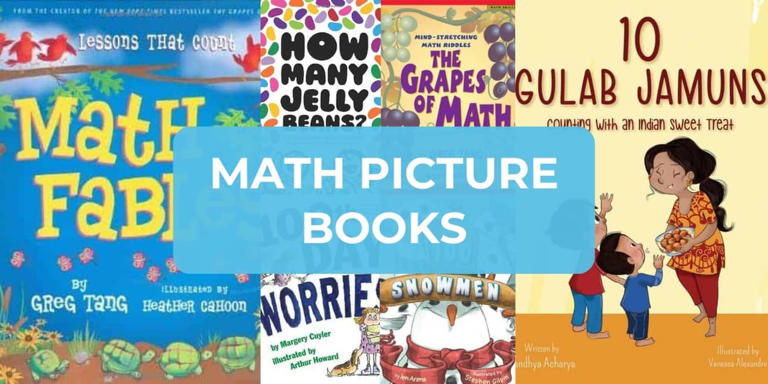

IMAGES
VIDEO
COMMENTS
Identify your areas for growth in these lessons: Dividing fractions by fractions. Dividing fractions word problems. Start quiz. Unit test. Test your understanding of Fractions with these NaN questions. Start test. In this topic, we will explore fractions conceptually and add, subtract, multiply, and divide fractions.
Word problems with fractions: involving a fraction and a whole number. Finally, we are going to look at an example of a word problem with a fraction and a whole number. Now we will have to convert all the information into a fraction with the same denominator (as we did in the example above) in order to calculate. This morning Miguel bought 1 ...
Problem Solving using Fractions. Fractions are numbers that exist between whole numbers. We get fractions when we divide whole numbers into equal parts. Here we will learn to solve some real-life problems using fractions. ...Read More Read Less. Select your child's grade in school: Grade. 1. Grade. 2. Grade. 3. Grade. 4. Grade. 5.
Math explained in easy language, plus puzzles, games, quizzes, videos and worksheets. For K-12 kids, teachers and parents. Fraction Worksheets ... Fractions - Subtraction. Worksheet. Example. Fractions (Same Denominator) 15 − 25. Unit Fractions. 13 − 19. Easy Proper Fractions. 38 − 27. Harder Proper Fractions. 712 − 1525.
Factor Fractions, examples with questions including solutions. Adding Fractions. Add fractions with same denominator or different denominator. Several examples with detailed solutions and exercises. Multiply Fractions. Multiply a fraction by another fraction or a number by a fraction. Examples with solutions and exercises.
To add fractions, they must have the same denominator. If they do, simply add the numerators together. [2] For instance, to solve 5/9 + 1/9, just add 5 + 1, which equals 6. The answer, then, is 6/9 which can be reduced to 2/3. 2. Subtract fractions with the same denominator by subtracting the numerators.
Analysis: To solve this problem, we will add two mixed numbers, with the fractional parts having unlike denominators. Solution: Answer: The warehouse has 21 and one-half meters of tape in all. Example 8: An electrician has three and seven-sixteenths cm of wire. He needs only two and five-eighths cm of wire for a job.
Unit 4 Understand fractions. Unit 5 Place value through 1,000,000. Unit 6 Add and subtract through 1,000,000. Unit 7 Multiply 1- and 2-digit numbers. Unit 8 Divide with remainders. Unit 9 Add and subtract fraction (like denominators) Unit 10 Multiply fractions. Unit 11 Decimals and place value. Unit 12 Add and subtract decimals.
How to solve Fraction Word Problems using Algebra? Examples: (1) The denominator of a fraction is 5 more than the numerator. If 1 is subtracted from the numerator, the resulting fraction is 1/3. Find the original fraction. (2) If 3 is subtracted from the numerator of a fraction, the value of the resulting fraction is 1/2.
Solving for the missing fraction (Opens a modal) Practice. Add fractions with unlike denominators Get 5 of 7 questions to level up! ... Add and subtract fractions word problems Get 3 of 4 questions to level up! Quiz 3. Level up on the above skills and collect up to 240 Mastery points Start quiz. Up next for you:
Solving subtraction problems with fractions. Subtracting fractions is a lot like regular subtraction. If you can subtract whole numbers, you can subtract fractions too! Click through the slideshow to learn how to subtract fractions. Let's use our earlier example and subtract 1/4 of a tank of gas from 3/4 of a tank.
Problem solving with fractions Problem solving is a fantastic way to put your knowledge into practise. Word problems can sometimes seem scary and more like a comprehension question in English.
Solution. Multiply both sides of the equation by the least common denominator for the fractions that appear in the equation. − 8 9x = 5 18 Original equation. 18( − 8 9x) = 18( 5 18) Multiply both sides by 18. − 16x = 5 On each side, cancel and multiply. 18( − 8 9) = − 16 and 18( 5 18) = 5.
A fraction is the ratio of two numbers.Most commonly, we consider rational numbers, those fractions which are the ratio of two integers or decimals.. An example of a fraction is .In the example, the numerator is and represents the number of individual parts of a given fraction, and the denominator is and represents the individual parts needed for the fraction to be one whole.
Improve your math skills. 😍 Step by step. In depth solution steps. ⭐️ Rating. 4.6 based on 20924 reviews. Free Fractions calculator - Add, Subtract, Reduce, Divide and Multiply fractions step-by-step.
5 problems similar to: Learn about fractions using our free math solver with step-by-step solutions.
Find three fractions that add to 1. Now the task has an endless number of solutions. These solutions can provide a lot of information about your students' facility with fractions. One student may add two halves to find one whole. Another may use a unit fraction and its complement such as 1/4 + 3/4 or 1/100 + 99/100. Task 4.
Lessons on solving fraction word problems using visual methods like bar models or tape diagrams. Here are some examples and solutions of fraction word problems. The first example is a one-step word problem. The second example shows how blocks can be used to help illustrate the problem. The third example is a two-step word problem.
Exploring Fractions. Introduction. At NRICH, our aim is to offer rich tasks which develop deep understanding of mathematical concepts. Of course, by their very nature, rich tasks will also provide opportunities for children to work like a mathematician and so help them develop their problem-solving skills alongside this conceptual understanding.
Grade 4: Fraction worksheets. Fractions to decimals. Grade 5: Fraction addition and subtraction. Fraction multiplication and division. Converting fractions, equivalent fractions, simplifying fractions. Fraction to / from decimals. Grade 6:
Press here to CLOSE X Instructions for Fractions Practice solving fractions with math student and teacher resources. Click on a box in the middle column to select the type of online fraction practice you would like to do. You can practice solving fractional equivalents, solving fraction greater than or less than problems, simplifying fractions to their lowest terms, adding fractions, dividing ...
This is a fraction calculator with steps shown in the solution. If you have negative fractions insert a minus sign before the numerator. So if one of your fractions is -6/7, insert -6 in the numerator and 7 in the denominator. Sometimes math problems include the word "of," as in What is 1/3 of 3/8?
Next: Fractions - Finding Original Practice Questions GCSE Revision Cards. 5-a-day Workbooks
Mystery Math: A First Book of Algebra by . David A. Adler, Edward Miller . Find the unknown number of creepy things by using addition, subtraction, multiplication, and division. Math Problem ...